
On March 10, my friend Silas arrived from the Faroe Islands early in the morning and my friend Nath from Australia arrived around noon. We were going to do a standard 2 week Usambara trip. Silas had been to Tanzania several times before, but Nath had never been here. Nath had a long target list so it was important to record all species.
Day 1, Sunday, March 10: Kiligolf.
When both had arrived, we did some garden birding before we took a walk on Kiligolf. In the garden, we recorded the following species: Scarlet-chested Sunbird, Red-billed Firefinch, Variable Sunbird, Red-cheeked Cordon-bleu, Northern Grey-headed Sparrow, Village Indigobird, Pale White-eye, Spectackled Weaver, Spotted Palm Thrush, Blue-capped Cordon-bleu, African Paradise Flycatcher, Red-headed Weaver, Red-backed Mannikin, Speckled Mousebird, Sombre Greenbul, Bronze Mannikin, Dark-capped Bulbul, Yellow-breasted Apalis, Diederik Cuckoo, Emerald-spotted Wood Dove, Red-throated Twinspot, Laughing Dove, Crested Francolin and Brown-hooded Kingfisher. We had lunch and went for an afternoon walk on Kiligolf: Violet-backed and Superb Starling, Chinspot Batis, Rattling Cisticola, Buff-bellied Warbler, Blue-naped Mousebird, Lesser Striped Swallow, Red-fronted Tinkerbird, Purple Grenadier, Wire-tailed Swallow, African Grey Flycatcher, Tropical Boubou, Brown-crowned Tchagra, Pied Kingfisher, African Pied Wagtail, Red-faced Cisticola, Tawny-flanked Prinia, Thick-billed Weaver, Malachite Kingfisher, Giant Kingfisher, Ovambo Sparrowhawk (New Kiligolf bird for me), African Grey Hornbill, Ring-necked Dove, Rock Martin, White-browed Coucal, Southern Citril, African Palm Swift and Yellow-fronted Canary. A good start for the trip.

Red-throated Twinspot, Hypargos niveoguttatus

Blue-capped Cordon-bleu, Uraeginthus cuanocephalus, Endemic to NE Africa
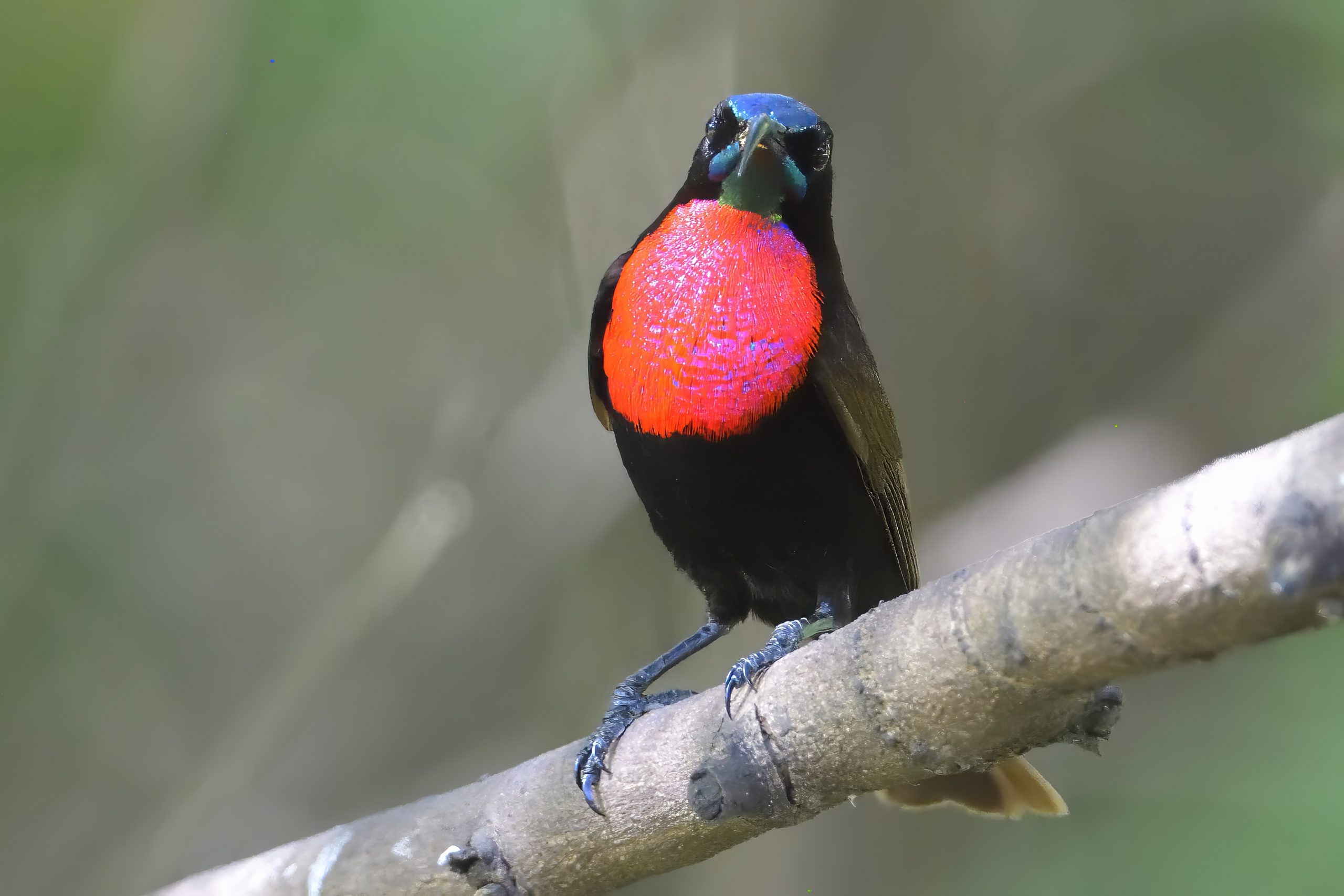
Scarlet-chested Sunbird, Chalcomitra senegalensis

African Grey Flycatcher, Melaenornis microrhynchus, Endemic to NE Africa

Tawny-flanked Prinia, Prinia subflava

Yellow-fronted Canary, Chritagra mozambica
Day 2: Monday, March 11: Kiligolf – Sakila Hills Wetland- Kiligolf
We met for coffee at 06:45, waited a little bit due to the light and were soon out birding on Kiligolf again. Here are some of the new species for Kiligolf that we recorded before breakfast: Red-faced Crombec, Jacobin Cuckoo, Thrush Nightingale, Black-backed Puffback, Yellow Bishop, Red-eyed Dove, Klaas´s Cuckoo, Pin-tailed Whydah, Long-tailed Fiscal, Hamerkop, Willow Warbler, African Pygmy Kingfisher, Hadada Ibis, Orange-breasted Bushshrike, Purple Heron, Common Sandpiper, Brubru, Wahlberg´s Eagle, Helmeted Guineafowl, Knob-billed Duck, Fork-tailed Drongo, Crimson-rumped Waxbill, Greater Painted Snipe, Black Crake, Striated Heron, Red-chested Cuckoo, White-browed Scrub Robin and Slate-colored Boubou. We had breakfast a little late and after breakfast I suggested that we checked out a wetland near Sakila hills to see if we could add some waterbirds during the heat of the day: Here are some of the species we observed: White-bellied Go-away-bird, Hildebrandt´s Starling, African Jacana, White-faced Whistling Duck, Intermediate Egret, Blacksmith Lapwing, Squacco Heron, African Swamphen, Little Grebe, Common Moorhen, African Pipit, White-backed Duck, Blue-billed Teal, Grey Heron, Yellow-billed Stork, Western Cattle Egret, Black-headed Heron, Northern Wheatear, Spur-winged Goose and Fulvous Whistling Duck. On the way home: Lilac-breasted Roller, Taveta Weaver and Three-banded Plover. We were home in time for lunch and at 16:00 we jumped in the car to bird Kiligolf around the clubhouse. It was still very hot, but we managed to pick up a few new species: Spotted Flycatcher, Pearl-spotted Owlet, Grey-headed Kingfisher, Little Swift, Golden-backed Weaver, Lesser Masked Weaver, White-rumped Swift, Nubian Woodpecker, Magpie Shrike and Gabar Goshawk.
We returned to our house freshened up and had a lovely dinner. We all retired early to bed.
Some pictures from Day 2:

Red-faced Crombec, Sylvietta whytii
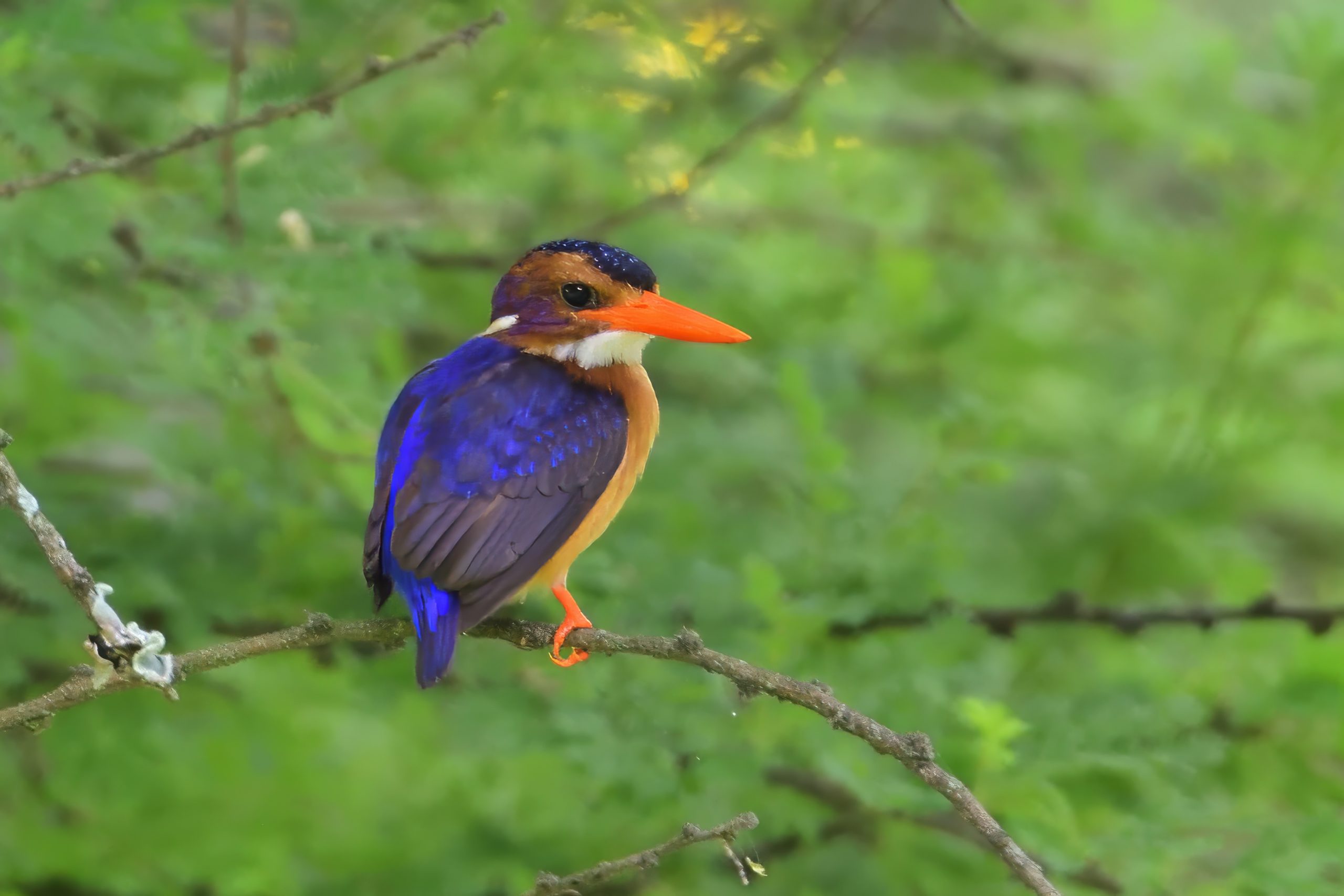
African Pygmy Kingfisher, Ispidina picta
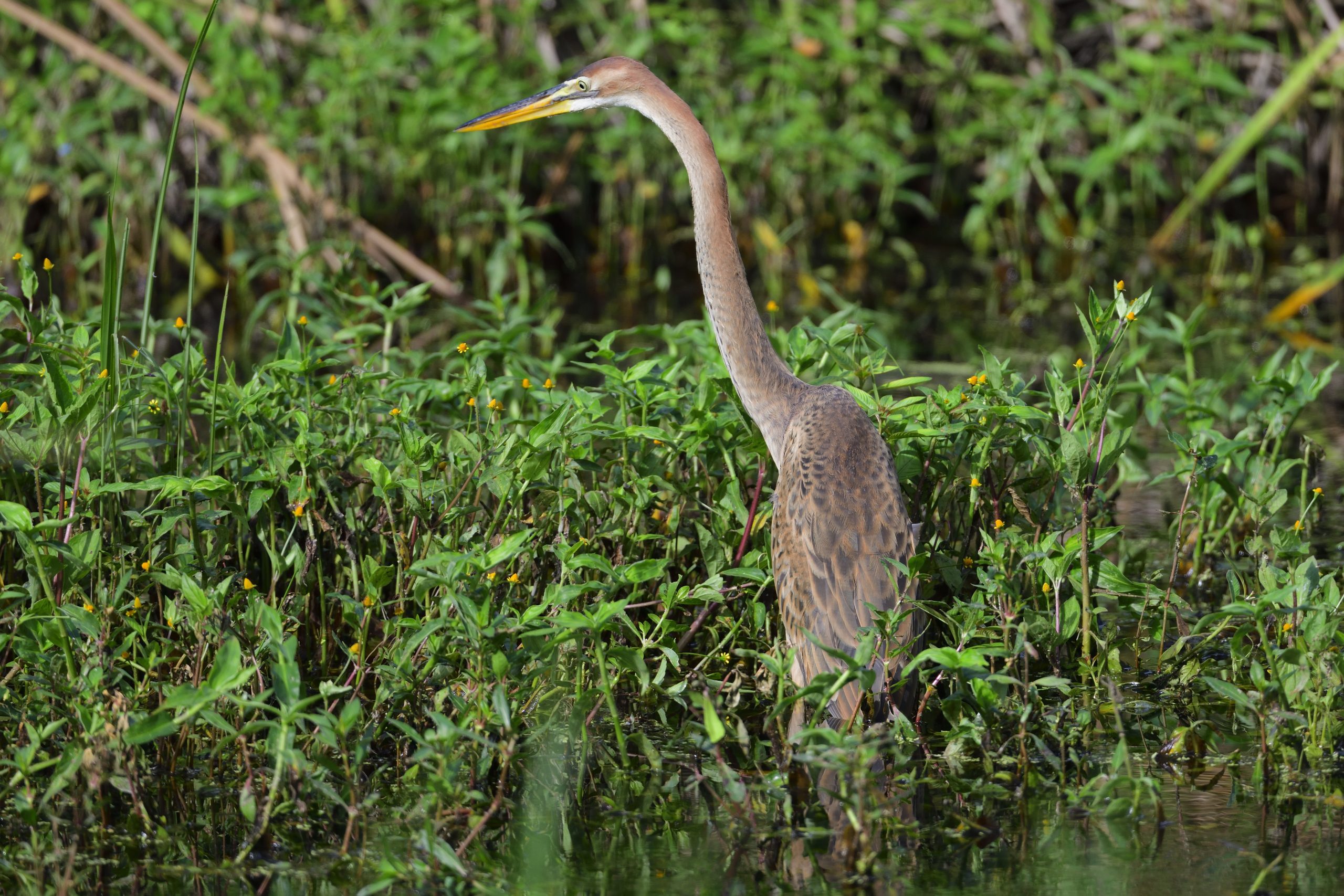
Purple Heron, Ardea purpurea

Malachite Kingfisher, Corythornis cristatus

Red-chested Cuckoo, Cuculus solitarius
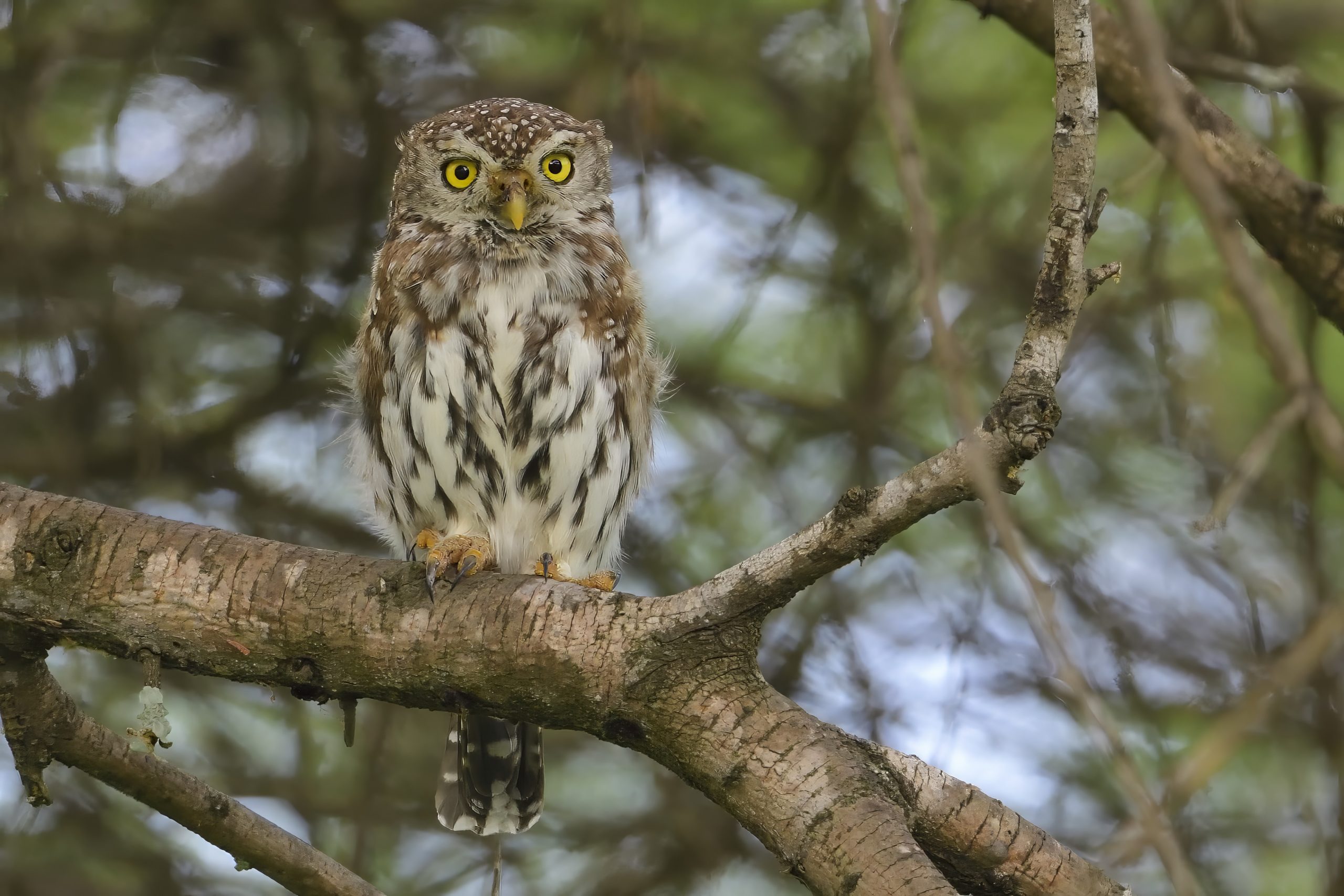
Pearl-spotted Owlet, Glaucidium perlatum

Grey-headed Kingfisher, Halcyon leucocephala

Red-cheeked Cordon-bleu, Uraeginthus bengalus

Purple Grenadier, Uraeginthus ianthinogaster, Endemic to NE Africa

Magpie Shrike, Urolestes melanoleucus
Day 3 – Tuesday March 12: Lark Plains, Oldonyo Sambu, Lengijave
We had an early start and were on the way to Lark Plains. We picked up an Augur Buzzard on the way. From the exit to the Lark Plains we started birding and here are some of the species we picked up before we parked the car: Augur Buzzard, Foxy Lark, Capped Wheatear, Rosy-patched Bushshrike, Diederik Cuckoo, Red-fronted Prinia, Amethyst Sunbird, Lesser Kestrel, Tiny Cisticola, Isabelline Wheatear, Taita Fiscal, Marico Sunbird, Chestnut-bellied Sandgrouse, Yellow-bellied Eremomela, Red-capped Lark and Crowned Lapwing. We parked the car and started walking towards the Masais waiting for us at the Beesley´s Lark. Then we flushed a bird. I too quickly assumed it were a Chestnut-bellied Sandgrouse, but Silas were more stubborn and even got some flight shots. It were identidied as a Quail Plover a lifer for me. We met up with the Masais took some pictures of the Beesley´s Lark, looked for Athi Short-toed and Short-tailed, but could not find them. We returned to the car and drove slowly towards the dry Acacia Forest near the Masai Bomas. On the way, we picked up: Kenya Sparrow, Short-tailed Lark, Fischer´s Sparrow-Lark, Fischer´s Starling, Beautiful Sunbird, Eastern Chanting Goshawk, Greater Kestrel, White-necked Raven, Black-faced Sandgrouse, White-bellied Canary, Northern White-crowned Shrike, Von der Decken´s Hornbill, Little Bee-eater and Red-fronted Barbet. We parked at my normal breakfast spot under a big Acacia tree and whilst having breakfast observed the following species: Grey-capped Social Weaver, Banded Parisoma, Cardinal Woodpecker, Nubian Woodpecker, Abyssinian Scimitarbill and Grey Wren-Warbler. We finished breakfast and took a walk in the dry Acacia Forest. It were very hot, but still a lot of activity as normal. Red-faced Crombec, Northern Wheatear, White-throated Robin, Pygmy Batis, Southern Grosbeak Canary, Red-throated Tit, Black-faced Waxbill and Wattled Starling were added to our list. We drove slowly towards Oldonyo Sambu and before we reached the main road, we found a flock of Scaly Chatterers. At Oldonyo Sambu we only had one target: Little Rock Thrush. We found a juvenile and and adult in addition we added the following species: House Sparrow, Horus Swift, Streaky Seedeater, Common Whitethroat, Speckled Pigeon and White-fronted Bee-eater. Birding in Oldonyo Sambu can be very good, but you are basically birding on a faul smelling garbage dump so we try to make the visit here as short as possible. We have found new places for many of the target birds we had at Oldonyo Sambu. We were soon on the way to our next destination, Lengijave. We started birding as soon as we took off from the main road. Here are some of the birds we found on our way towards our picnic spot: Schalow´s (Abyssinian) Wheatear, Baglafecht Weaver, Red-and-yellow Barbet, Black Bishop and Singing Cisticola. At the lunch spot we found Malachite Sunbird, Arrow-marked Babbler, Lyne´s Cisticola, Bronzy Sunbird, Yellow Bishop, Dusky Turtle Dove, Brown-crowned Tchagra and Long-billed Pipit. On the way back to the main road: Northern Fiscal, Golden-backed Weaver and Reichenow´s Seed-eater and on the way home the first of many Yellow-billed Kites on our trip. We arrived home, freshened up and had a nice dinner again. As normal, we retired early to bed.
Some pictures from Day 3:

Beesley´s Lark, Chersomanes beesleyi, Endemic to a small area north of Arusha Tanzania

Crowned Lapwing, Vanellus coronatus

Short-tailed Lark, Spizocorys fremantlii, Endemic to NE Africa

Abyssinian Scimitarbill, Rhinomastus minor, Endemic to NE Africa

White-throated Robin, Irania gutturalis

Pygmy Batis (female), Batis perkeo, Endemic to NE Africa

Red-throated Tit, Melaniparus fringillinus, Endermic to N Tanzania and S Kenya
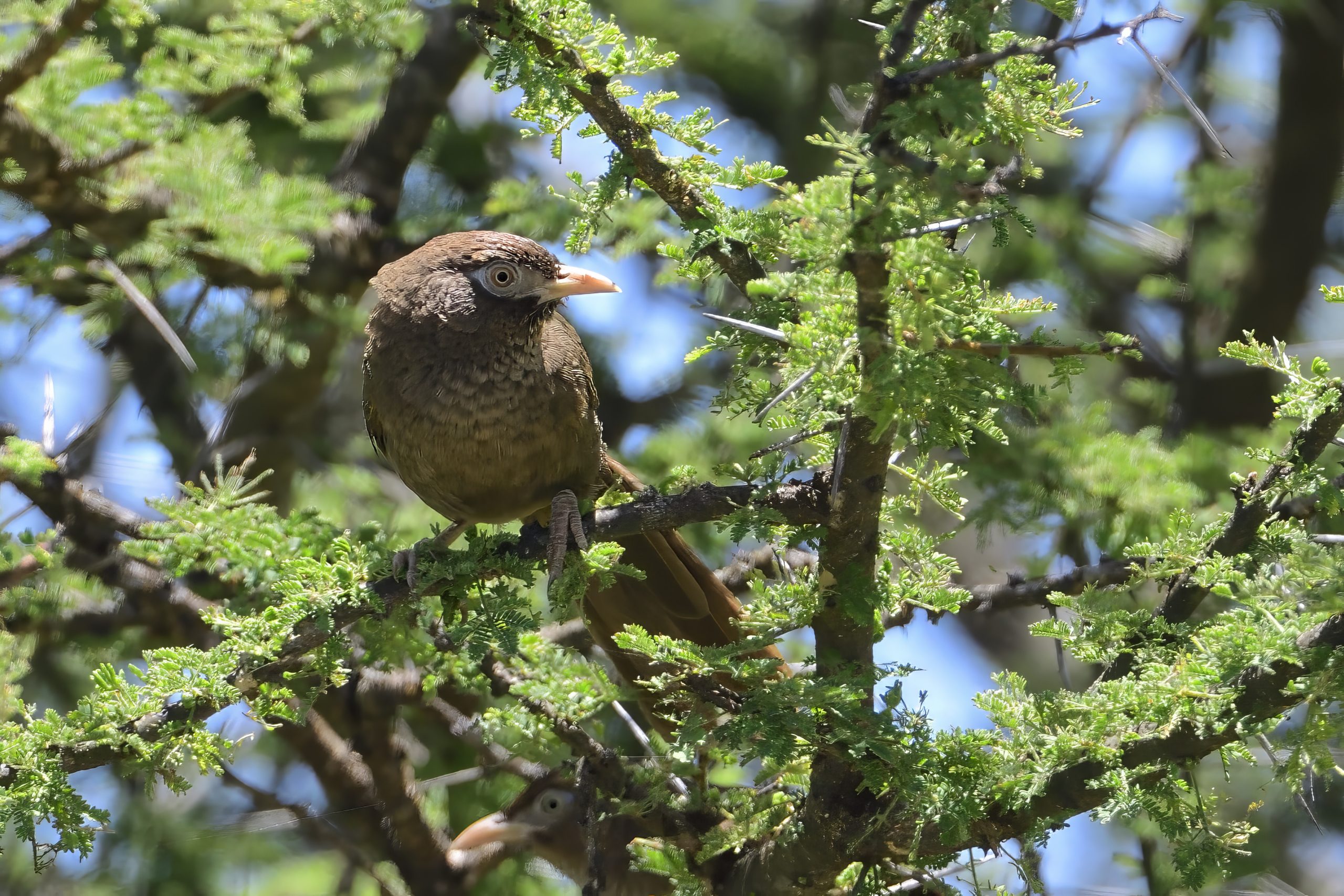
Scaly Chatterer, Argya aylmeri, Endemic to NE Africa

Rosy-patched Bushshrike, Telophorus cruentus, Endemic to NE Africa

Little Rock Thrush, Monticola rufocinereus, Endemic to NE Africa

Red-and-yellow Barbet, Trachyphonus erythrocephalus, Endemic to NE Africa

Black Bishop, Euplectes gierowii

Malachite Sunbird, Nectarina famosa

Yellow Bishop, Euplectes capensis

Lyne´s Cisticola, Cisticola distinctus, Endemic to E Africa

Brown-crowned Tchagra, Tchagra australis

Bronzy Sunbird (Juvenile), Nectarina kilimensis

Schalow´s (Abyssinian) Wheatear, Oenanthe Schalowi

White-fronted Bee-eater, Merops bullockoides
Day 4, Wednesday, March 13: Tarangire NP – Karatu
Again an early start. After Makuyuni, we picked up a flock of Abdim´s Storks. We started birding on the road from the main road to the park and added amongst others the following species: African Wattled Lapwing, Gabar Goshawk, White-browed Sparrow-Weaver, White-headed Buffalo Weaver, Red-bellied Parrot, Black-chested Snake Eagle, Southern Red Bishop, Beautiful Sunbird and Yellow-collared Lovebird. The boys went birding while I paid the entrance fees. This went very quick and we were soon on our way to our breakfast spot. Here are some of the species we picked up: Rufous-tailed Weaver, Northern Red-billed Hornbill, Ashy Starling, Eastern Grey Woodpecker, Yellow-necked Spurfowl, Desert Cisticola, Bare-faced Go-away-bird, Red-billed Buffalo Weaver, Swahili Sparrow, Bateleur, Speckle-fronted Weaver, Cut-throat Finch, Rufous-naped Lark, African Hoopoe, Black-necked Weaver, D´Arnaud´s Barbet, Diederik Cuckoo, Red-necked Spurfowl, Woodland Kingfisher, Grey Crowned Crane, Blue-cheeked Bee-eater, Egyptian Goose, Common Greenshank, Dwarf Bittern, Striated Heron, Yellow-billed Stork, Knob-billed Duck, Red-billed and Yellow-billed Oxpeckers (On the same Giraffe). We stopped at our breakfast spot, had our breakfast and were soon on our way. On the way to our normal lunch spot we added: White-backed Vulture, a huge flock of Collared Pratincoles, Grey Kestrel, Jacobin Cuckoo, Grey-headed Kingfisher, Steppe and Tawny Eagles, Barn Swallow, Alpine and African Black Swift, Black-headed Oriole, Green-winged Pytilia, Long-tailed Paradise Whydah, Common Ostrich, Wood Sandpiper, Mosque Swallow, another Dwarf Bittern and Northern Pied Babbler. We were now close to our lunch site, but we decided it were too early for lunch, so we continued on my”Bustard Road”. Here are some of the birds we picked up towards the gate: Double-banded Courser, White-bellied and Buff-crested Bustards, Spotted Thick-knee, Lappet-faced Vulture, Southern Ground Hornbill, Brown Snake Eagle, Pangani Longclaw, Namaqua Dove, European Roller, Pygmy Falcon and Silverbird. We had lunch at the gate and I photographed a Common Cuckoo. After the late lunch, we drove to Karatu and checked in to my normal guest house. We freshened up and went across the road for a local dinner. We returned to our guest house and retired early.
Some pictures from Day 5:

Black-chested Snake Eagle, Circaetus pectoralis

Yellow-necked Spurfowl, Pternistis leucoscepus, Endemic to NE Africa

Swahili Sparrow, Passer suahelicus
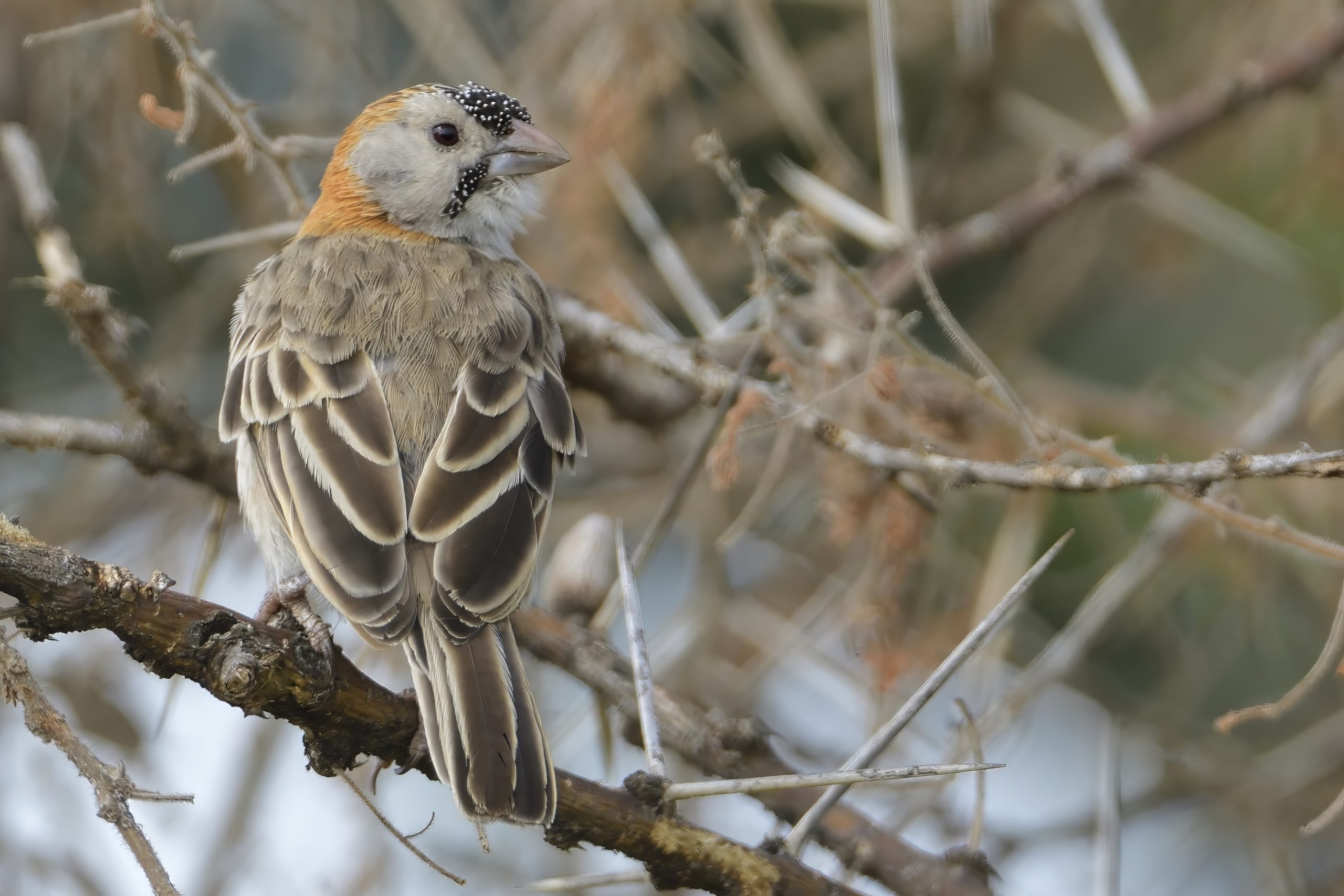
Speckle-fronted Weaver, Sporopipes frontalis

D´Arnaud´s Barbet, Trachyphonus darnaudii, Endemic to NE Africa

Diederik Cuckoo (Female), Chryssococcyx caprius

Woodland Kingfisher (Juvenile), Halcyon senegalensis

Blue-cheeked Bee-eater, Merops persicus
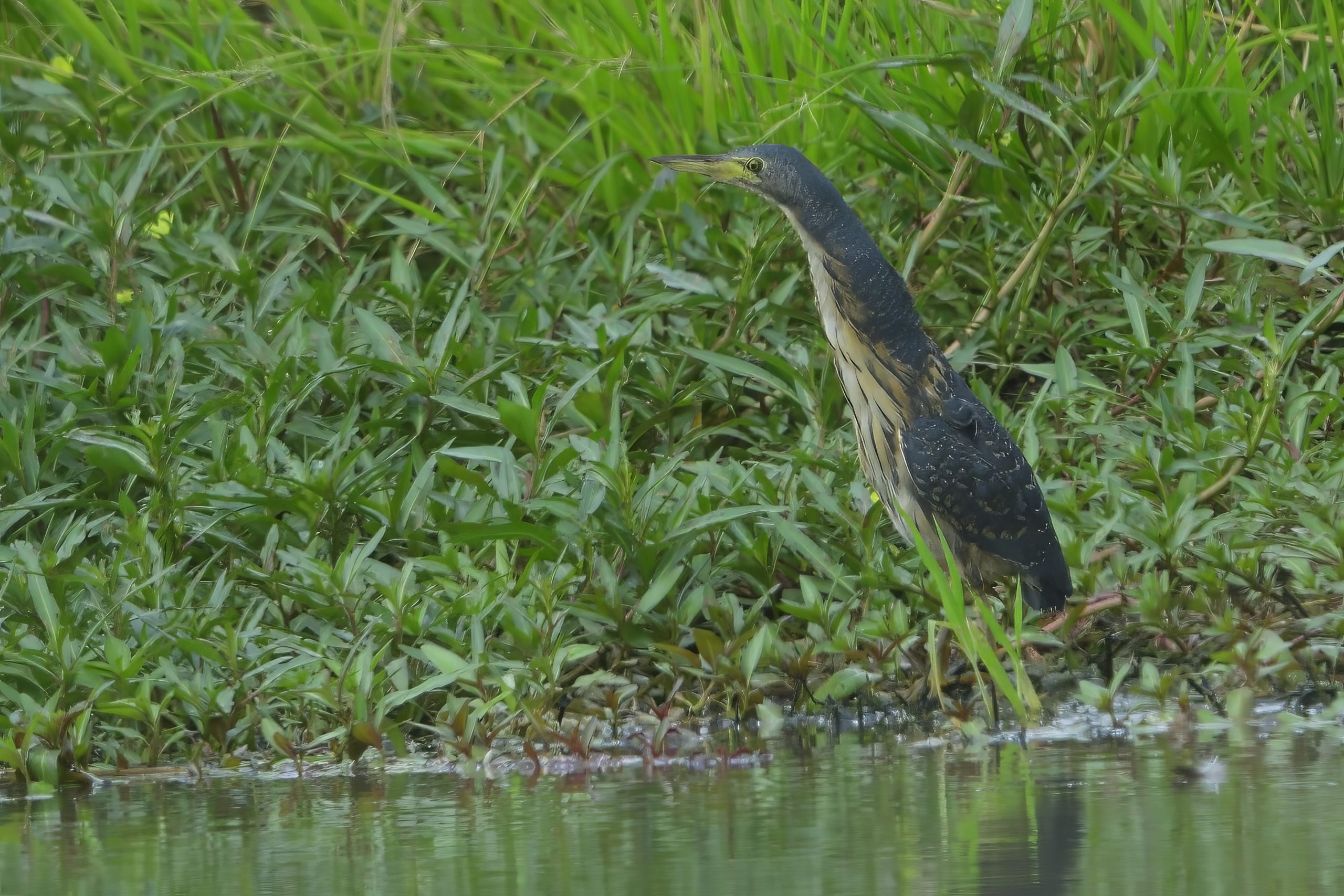
Dwarf Bittern, Ixobrychus sturmii

Striated Heron, Butorides striata

Yellow-billed Stork, Mycteria ibis

Knob-billed Duck, Sarkidornis melanotos

Jacobin Cuckoo, Clamator jacobinus

Grey-headed Kingfisher, Halcyon leucocephala

African Black Swift, Apus barbatus

Yellow-billed Oxpecker, Buphagus africanus

Tawny Eagle Aquila rapax

Northern Pied Babbler, Turdoides hypoleuca, Endemic to E Africa
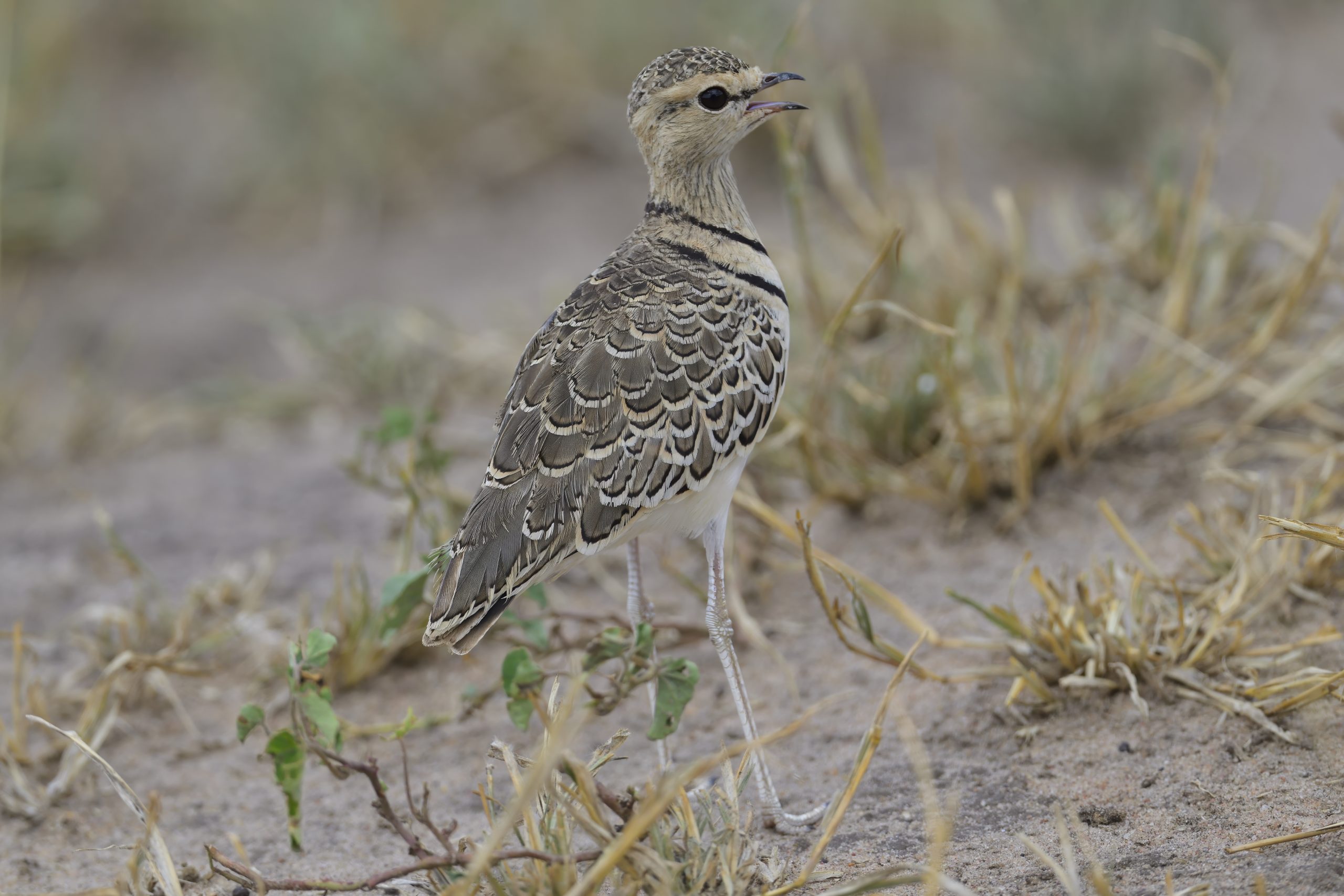
Double-banded Courser, Rhinoptilus africanus

White-bellied Bustard, Eupodotis senegalensis
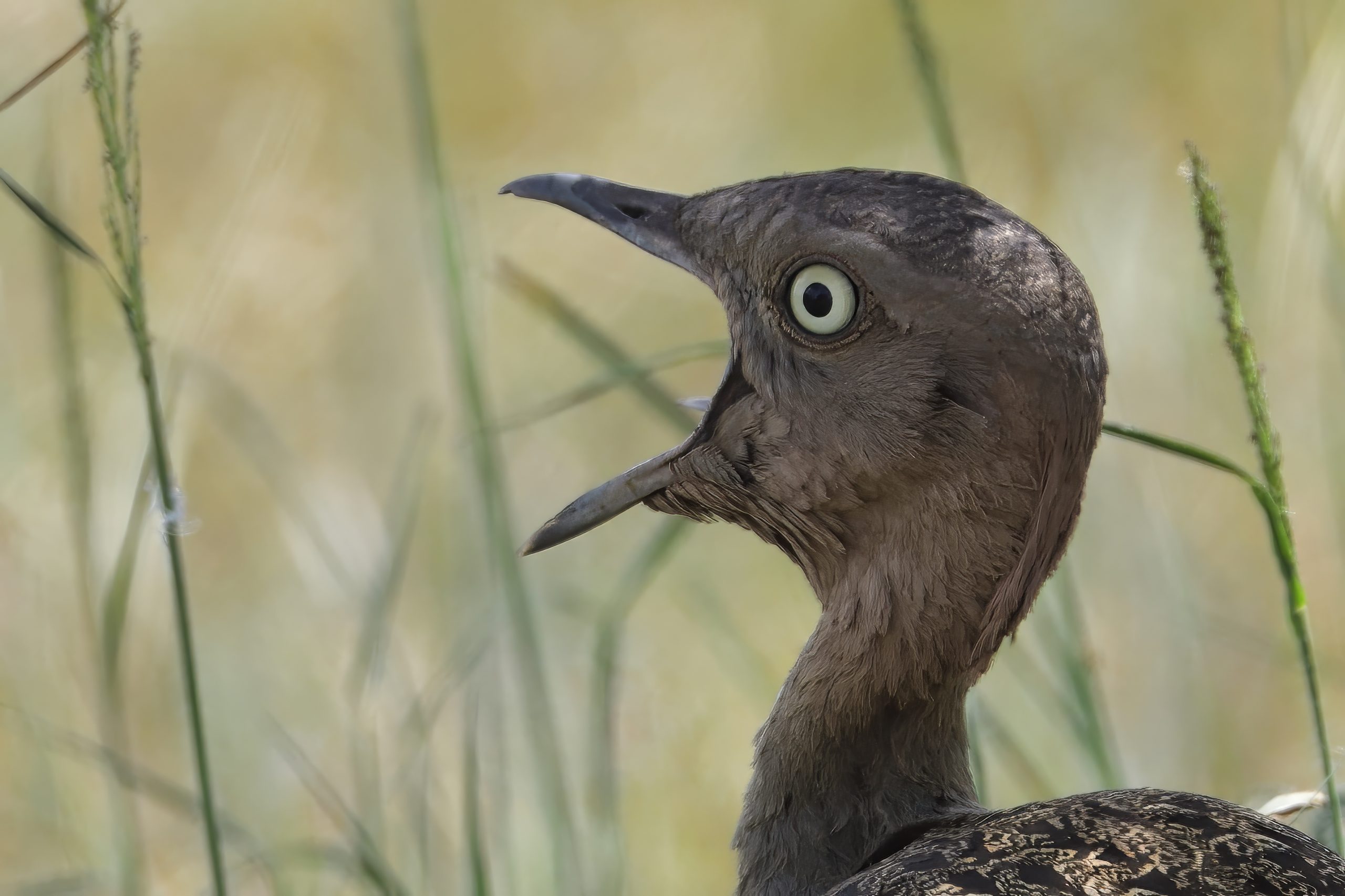
Buff-crested Bustard, Lophotis gindiana, Endemic to NE Africa

Lappet-faced Vulture, Torgos tracheliotos

European Roller, Coracias garrulus

Pygmy Falcon, Polihierax semitorquatus
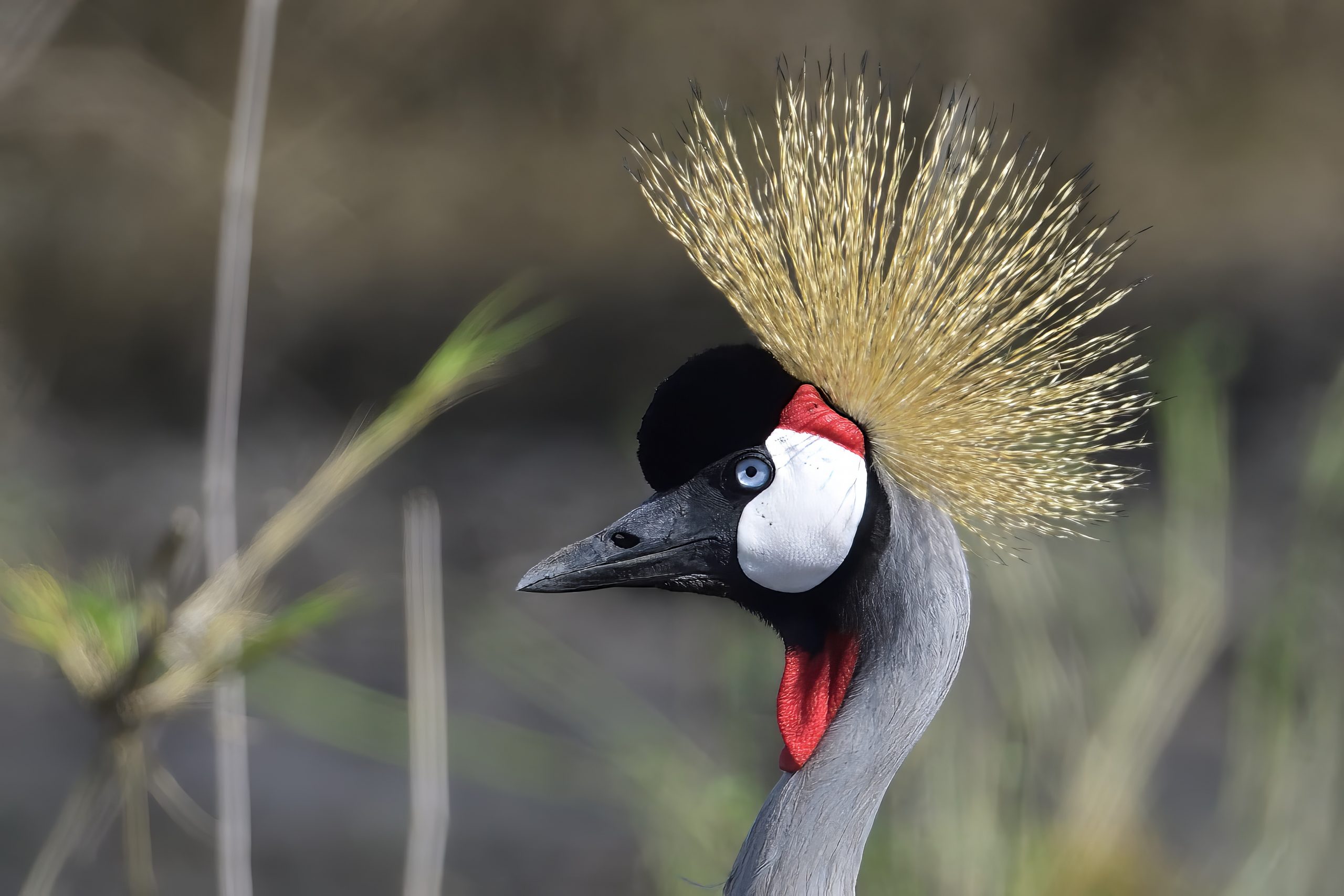
Grey-crowned Crane, Balearica regulorum

Common Cuckoo, Cuculus canorus
Day 5, Thursday, March 14: Karatu – Endoro Trail, Lake Eluanata – Kiligolf
We only had 5 km to the entrance to the Enduro Trail from our guest house so we could sleep one hour longer that morning. Just when we left, we saw the resident pair of Fischer´s Lovebirds sitting on a wire outside our guest house. Our local guide Emmanuel were waiting for us at the head of the trail and we started birding. Here are some of the birds we saw on the way up to the Elephant Caves: Eastern Double-collared Sunbird, White-browed Robin-Chat, Tropical Boubou, Grey Olive Greenbul, African Dusky Flycatcher, Tambourine Dove, Grey Capped Warbler, Mountain Greenbul, Cinnamon-chested Bee-eater, Black-fronted Bushshrike, Red-throated Twinspot, Schalow´s Turaco, Brown-headed Apalis, Hildebrandt´s Spurfowl, White-eyed Slaty Flycatcher, White-tailed Blue Flycatcher, Mbulu White-eye, Collared Sunbird, Grey-headed Nigrita, Cape Robin-Chat, Bar-throated Apalis, Moustached Tinkerbird, Klaas´s Cuckoo, Grey Cuckooshrike, Black-throated Wattle-eye, Abyssinian Thrush, Yellow-bellied Waxbill and Thick-billed Seed-eater. We had breakfast and found Purple-throated Cuckooshrike. On the way down, it were getting hot and the forest died down so we did not add any new species. We left for Lake Eluanata. On the way in we found a Black-winged Kite. We drove first on the north side of the lake and added Chestnut Sparrow, Cut-throat Finch, Quailfinch, Southern Red Bishop and Red-billed Teal. We then tried the Grassland for Coqui Francolin, but the grass were too high. instead we flushed a Harlequin Quail twice and a Corn Crake (Lifer) once. The only other new bird on the western shore were White-winged Widowbird. We drove home, freshened up, had dinner and retired early to bed.
Some pictures from Day 5:
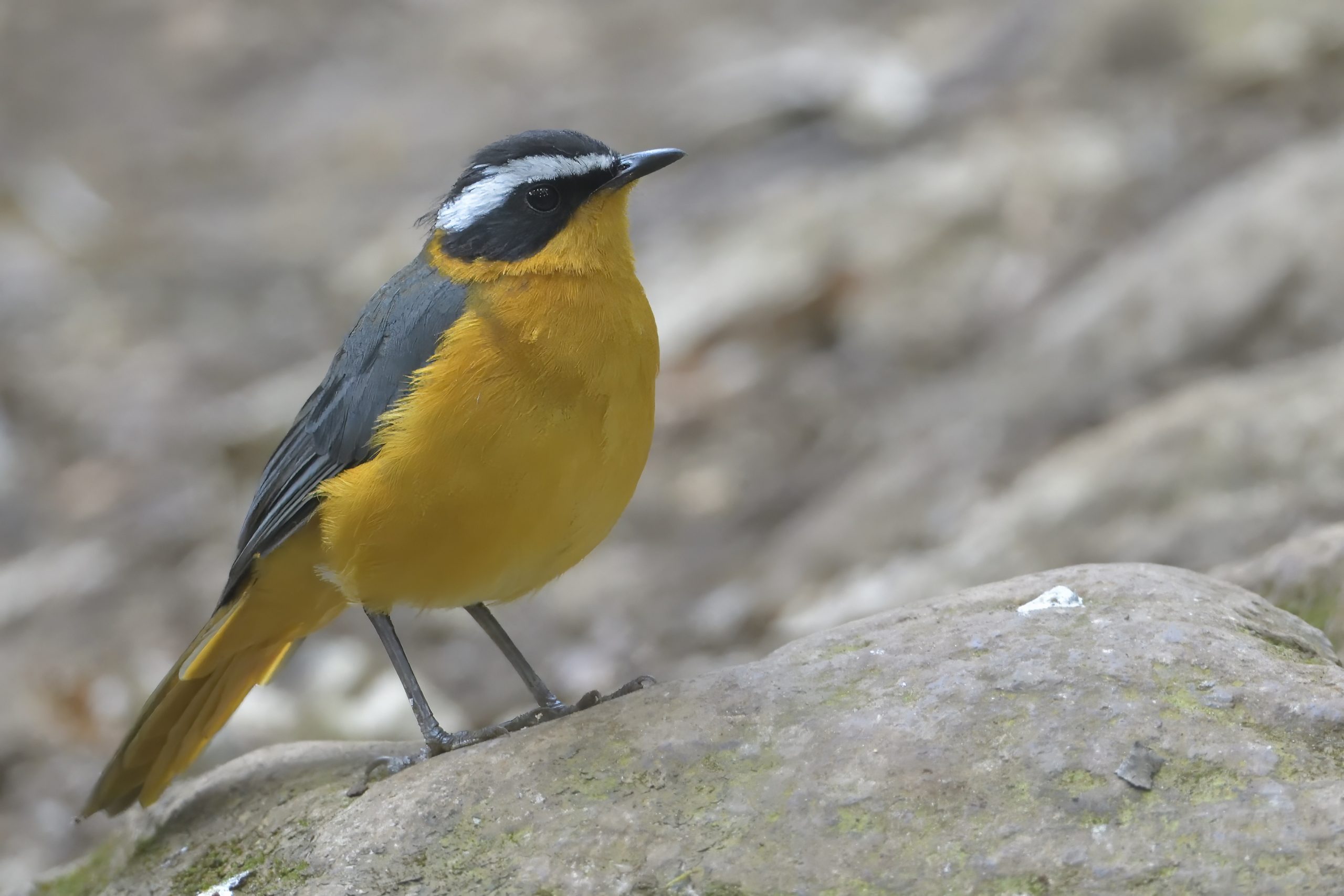
White-browed Robin-Chat, Cossypha heuglini

Tropical Boubou, Laniarius major

Grey-capped Warbler, Eminia lepida

Mountain Greenbul, Arizelocichla nigriceps, Endemic to Highland forests of N Tanzania and S Kenya

Moustached Tinkerbird, Pogoniulus leucomystax

Yellow-bellied Waxbill, Coccopygia quartinia

Abyssinian Thrush (Juvenile), Turdus abyssinicus

Klaas´s Cuckoo, Chrysococcyx klaas

Bar-throated Apalis, Apalis thoracica race murina
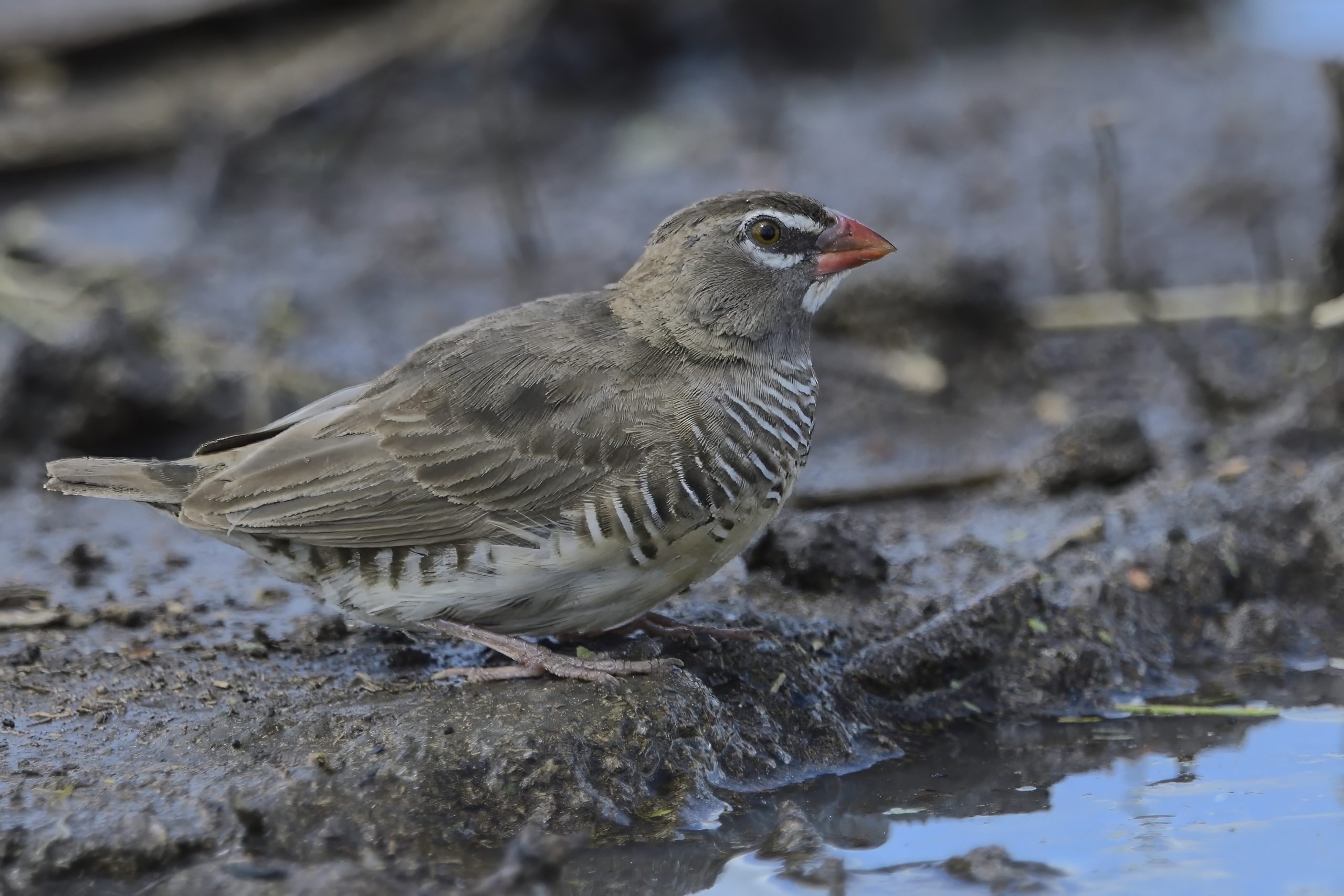
Quailfinch, Ortygospiza atricollis

Cut-throat Finch (female), Amadina fasciata

Southern Red Bishop, Euplectes orix

Three-banded Plover, Charadrius tricollaris
Day 6, Friday, March 15: Masai Steppes
We again had a semi early start and arrived at our birding spot just before 08:00. These are some of the birds we registered before we reached our breakfast spot: Parrot-billed Sparrow, Hunter´s Sunbird, Easrern Violet-backed Sunbird, Bare-eyed Thrush, Eastern Chanting Goshawk, White-headed Mousebird, Pink-breasted Lark, Eurasian Hobby, Common Rock Thrush, Pink-backed Pelican!, Tsavo Sunbird, Mouse-colored Penduline Tit, Golden-breasted Starling, Straw-tailed Whydah and Black-throated Barbet. We stopped at my normal Breakfast spot and did a small walk after breakfast. The usually very active area around our breakfast spot were very dead that day. We drove off to the nearest nesting colony for Black-necked Weaver. I checked the area for Acacia Tit, but no luck. We drove back towards Shambalaya Dam. Just shy of the exit to the dam, we found a little seep that housed 3 species of Whydah´s: Long-tailed Paradise, Steel-blue and Straw-tailed + a flock of Cut-throat Finch, White-bellied Canary and Namaqua Dove. We drove down to the dam, but as expected the water level were still too high. We still managed to add some birds: Whiskered Tern, Spur-winged Lapwing, African Fish Eagle and Little Egret. With so much water, the road towards the airport is normally good for more water birds so we decided to take the long way home. However; nothing new were found. We returned home and Nath had some sad news: Due to some serious illness in his near family, he had to cut the trip short and fly out the next morning. He had still managed to get about 240 lifers. I packed the car for the Safari that were supposed to start the day after. We freshened up, had dinner and retired early to bed.
Some pictures from Day 6:

Eastern Chanting Goshawk (Juvenile), Melierax poliopterus, Endemic to NE Africa

Pink-breasted Lark, Calendulauda poecilosterna, Endemic to NE Africa

Black-capped Social Weaver, Pseudonigrita cabanisi, Endemic to NE Africa

Long-tailed Paradise Whydah, Vidua paradisea

Long-tailed Paradise Whydah (female), Vidua paradisea

Straw-tailed Whydah, Vidua fischeri, Endemic to NE Africa

Straw-tailed Whydah (female), Vidua fischeri, Endemic to NE Africa

Steel-blue Whydah, Vidua hypocherina, Endemic to NE Africa

Cut-throat Finch, Amadina fasciata

White-bellied Canary, Crithagra dorsostriata, Endemic to NE Africa
Day 7, Saturday, March 16: Kiligolf – Nymba Ya Mungu Dam – South Pare Mountains – Same
Then there were two. Silas and I started the Safari alone. We picked up our guide Martin Joho at the exit to Nyumba ya Mungu Dam. We drove straight to the Dam and had breakfast there. We started adding birds: Black-winged Stilt, Whiskered Tern, Reed Cormorant, Great Egret, Gull-billed Tern, Brown-throated Martin and Western Yellow Wagtail were found at our breakfast spot. Silas main target were African Skimmer. The water level were too high to follow the shore so after a lot of trial and error, we finally found a passable road and yes a nice flock of African Skimmers. His secondary target were Water Thick-knee. We found quite a few of them as well. Other birds around the dam included: Glossy Ibis, Grey Heron, African Openbill, Ruff, Great White Pelican, Common Ringed Plover, Sanderling, Little Stint, Curlew Sandpiper, Marsh Sandpiper, Grey-headed Gull, Temminck´s Stint, Kittlitz´s Plover and White-winged Tern. We drove back and followed the new road discovered and were back to the dam wall very quickly. We stopped on the way to the main road for Silas to find 2 missing targets from the Masai Steppes: Somali Bunting and Pringle´s Puffback. Both were found. We were running late and did not stop for lunch in Same as we normally do, but headed straight up South Pare Mountains. We picked up a flock of Abdim´s Storks on the way. Our main target in the mountains were the South Pare White-eye. We saw a few, but did not really get any good photo opportunities. Other birds found up South Pare Mountains included: Red-rumped Swallow, Black Saw-wing, Usambara Double-collared Sunbird, African Firefinch, Stripe-faced Greenbul, African Stonechat and Eastern Bronze-naped Pigeon. We drove down the mountain and checked in to Elephant Motel in Same. We freshened up, had dinner and I retired early.
Some pictures from Day 7:

Western Yellow Wagtail, Motacilla flava

Grey Heron, Ardea cinerea

Water Thick-knee, Burhinus vermiculatus

Kittlitz´s Plover, Charadrius pecuarius

African Skimmer, Rynchops flavirostris
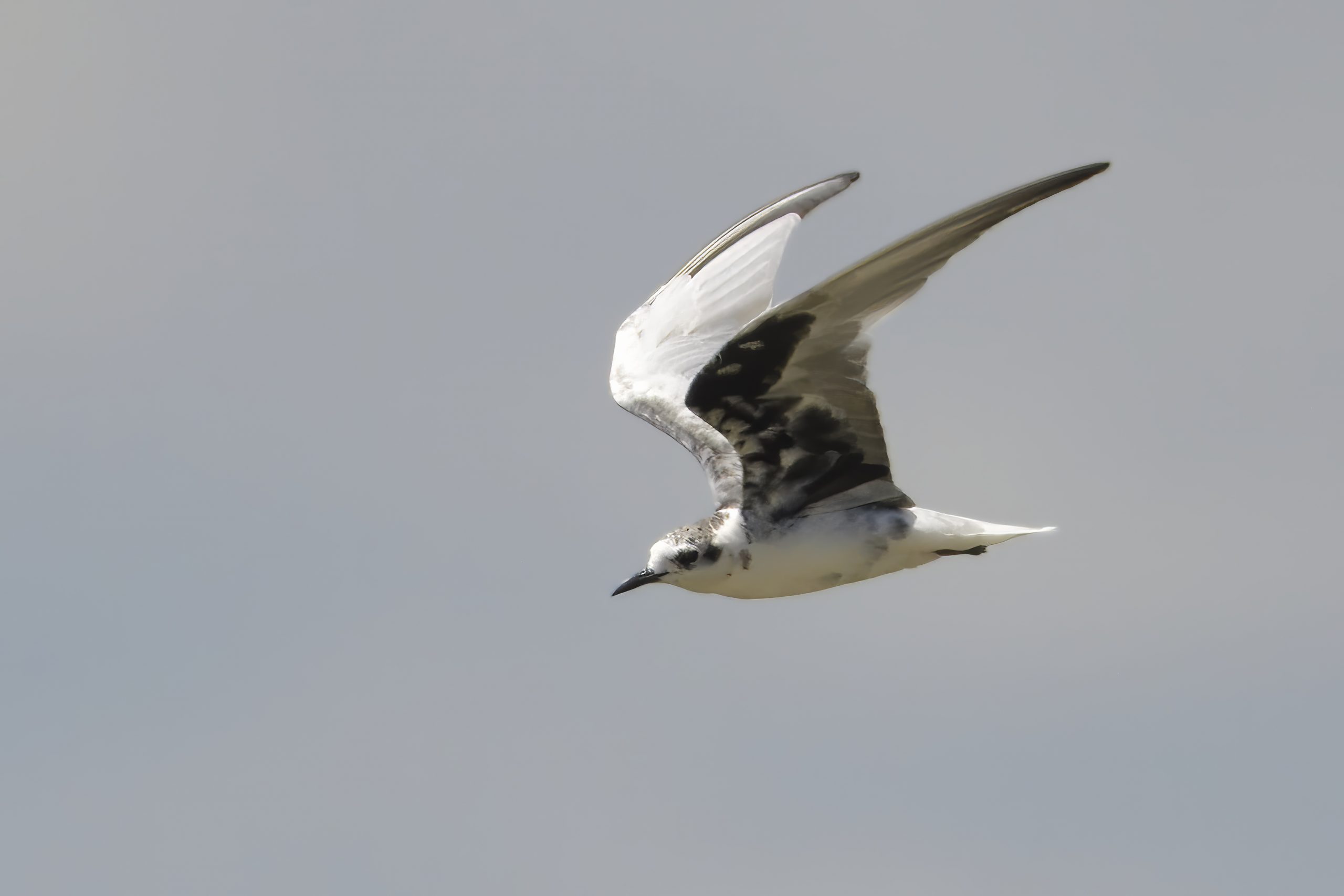
White-winged Tern, Chlidonias leucopterus

Abdim´s Stork, Ciconia abdimii

South Pare White-eye, Zosterops winifredae, Endemic to Pare Mountains in Tanzania

Willow Warbler, Phylloscopus trochilus
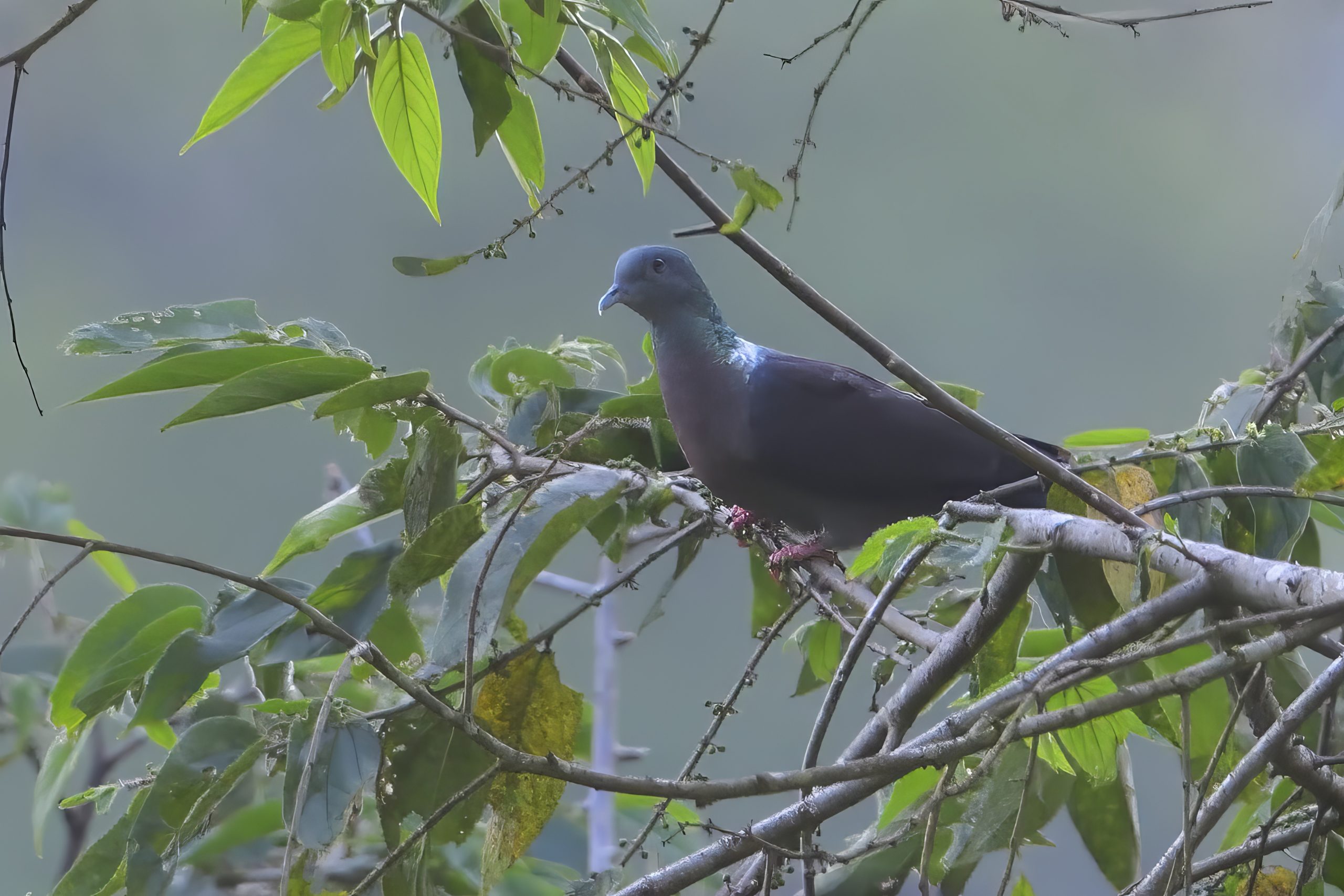
Eastern Bronze-naped Pigeon, Columba delegorguei
Day 8, Sunday, March 17: Same – Magamba Forest West Usambara
We picked up Martin from his lodgings at 06:45 and headed for a birding spot next to Mkomazi NP that Martin and I discovered many years ago. We had a couple of targets for Silas here. We parked the car and started a little walk. here are some of the birds we found that morning: Grey-headed Bushshrike, White-browed Sparrow-Weaver, Black Cuckooshrike, Black Saw-wing, Tree Pipit, Southern Black Flycatcher, Eastern Black-headed Batis, D´Arnaud´s Barbet, Grey-headed Silverbill, Yellow-spotted Bush Sparrow, Southern Grosbeak Canary, Lesser Honeyguide and Red-bellied Parrot. We had missed one of the target species, Black-bellied Sunbird, but I knew a spot a short drive away and we picked up that and also a nice photo opportunity of Hunter´s Sunbird. The last bird that morning were a White-winged Widowbird. We went back to the Motel, had breakfast, Packed and were soon ready for the drive to Magamba Forest, West Usambara. Just before we arrived in Mombo, we picked up a Woolly-necked Stork. We filled Diesel in Mombo and started up the mountain on the old German road. Just before Soni, we stopped at our regular spot and picked up a few birds: Mountain Wagtail, Grey Olive Greenbul, Eastern Golden Weaver and East Coast Boubou. We pushed on to Soni where we stopped for some supplies, drove past Lushoto and were at the gates of Magamba around 14:30. We drove up to camp. Set up camp and did an afternoon Bird Walk uphill. Here are some of the species we observed: White-starred Robin, Usambara Thrush, Red-capped Forest Warbler, Usambara Akalat, White-tailed Crested Flycatcher, Hartlaub´s Turaco, Moustached Tinkerbird, Southern Yellow White-eye and at night I heard an African Wood Owl. We returned to camp. I have had the local Chicken boil for about 3 hours. Martin helped me chop some vegetables and we had a nice chicken stew, spent some time at the bonfire and then retired early to our tents.
Some pictures from Day 8:

White-browed Sparrow-Weaver, Plocepasser mahali
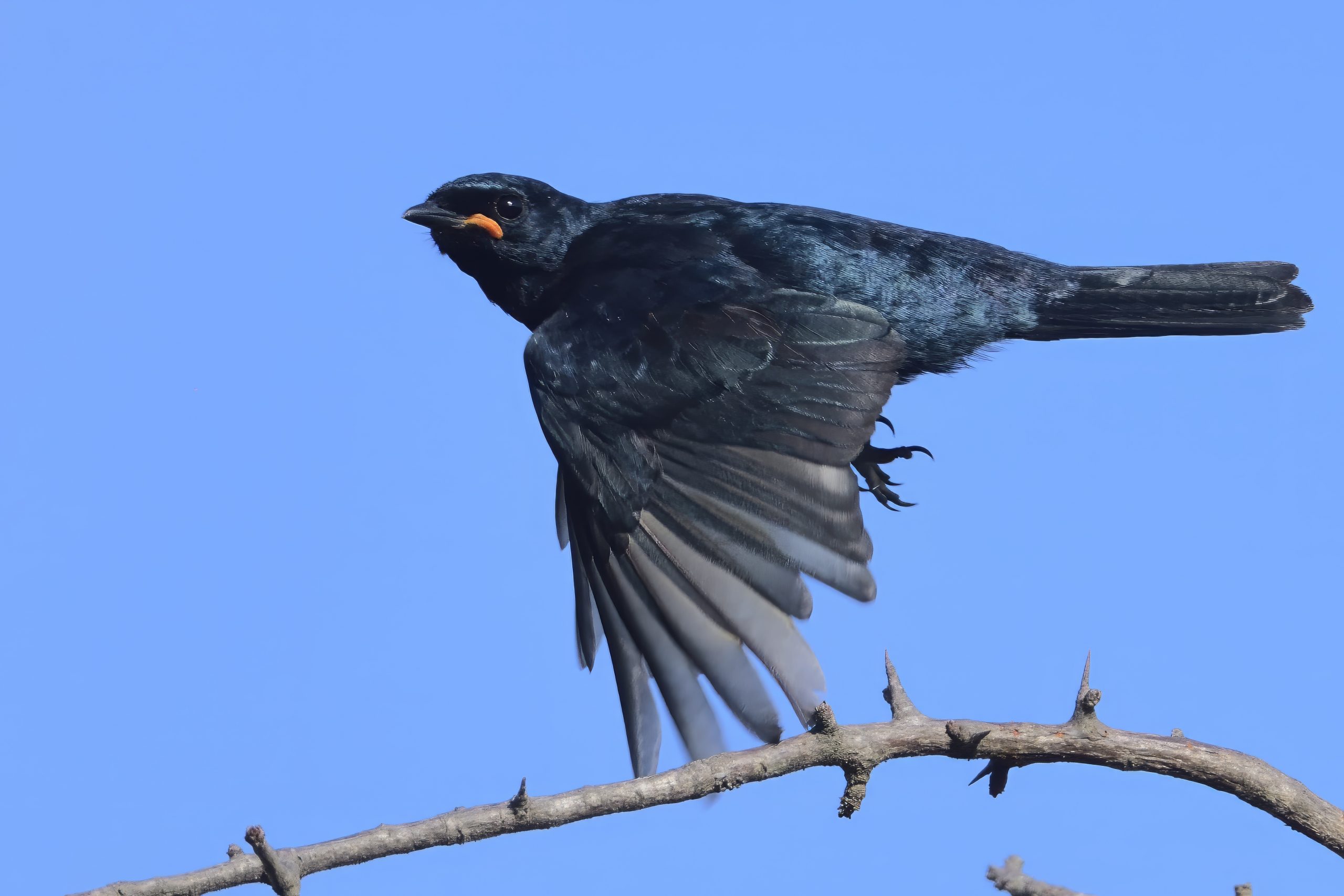
Black Cuckooshrike (male), Camphega flava

Black Cuckooshrike (female), Camphega flava

Balck Saw-wing, Psalidoprocne pristoptera

Southern Grosbeak Canary, Cgritagra buchanani, Endemic to N Tanzania and S Kenya
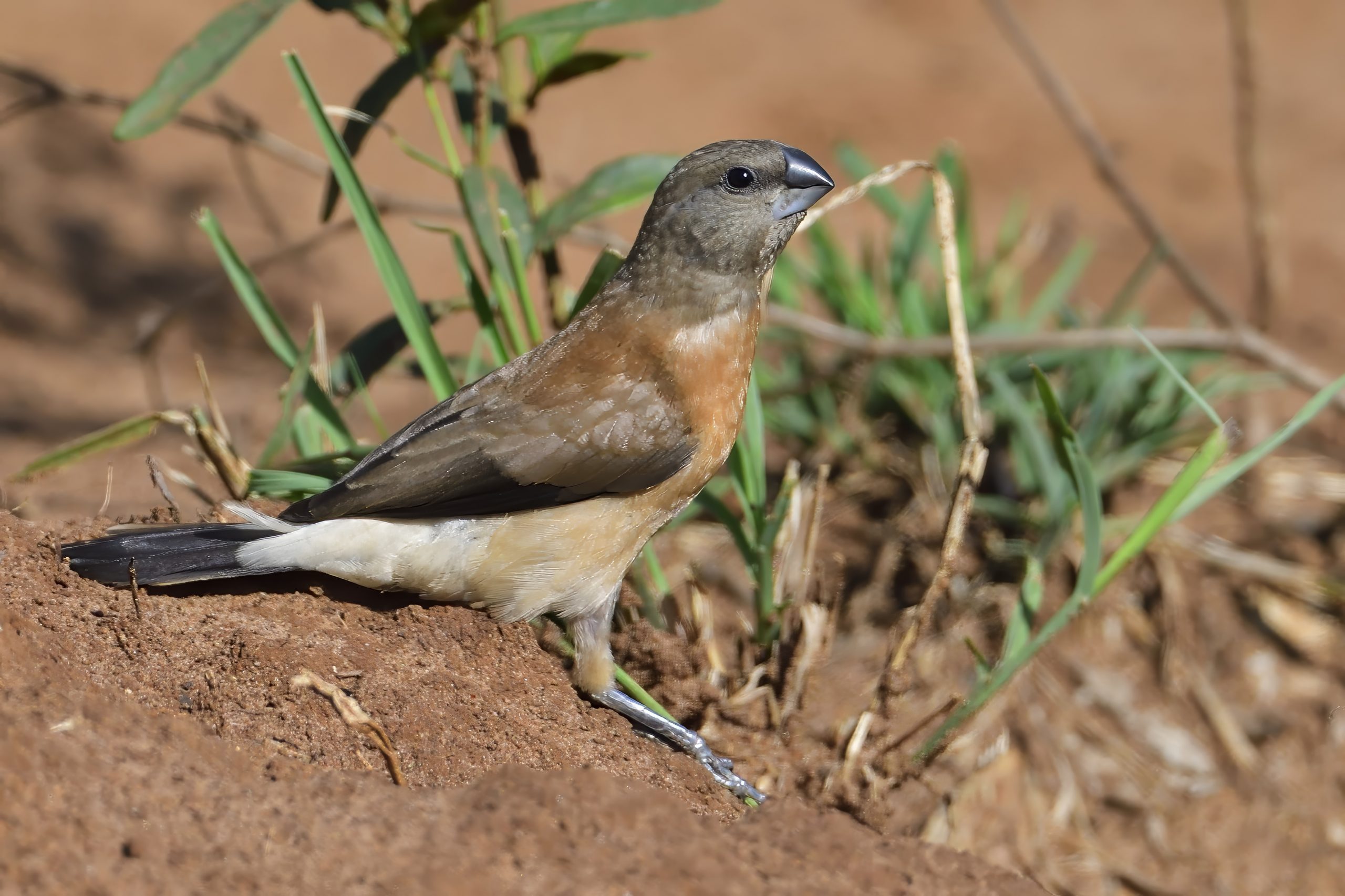
Grey-headed Silverbill, Spermestes griseipilla, Endemic to NE Africa

Hunter´s Sunbird, Chalcomitra hunteri, Endemic to NE Africa

Black-bellied Sunbird, Cinnyris nectarinioides, Endemic to NE Africa

White-winged Widowbird, Euplectes albonotatus

Grey-olive Greenbul, Phyllastrephus cerviniventris

Eastern Golden Weaver, Ploceus subaureus

Red-capped Forest Warbler, Artisornis metopias, Endemic to Eastn Arc Mountains of Tanzania and N Mozambique
Day 9, Tuesday, March 18: Magamba Forest.
We met for coffee at 06:45 and then decided to walk uphill. We only added a few new birds to our Magamba list: Olive Sunbird, Cinnamon Bracken Warbler, Bar-tailed Trogon, Yellow-bellied Waxbill, Usambara Double-collared Sunbird and we heard Spot-throat. We also photographed the only endemic Chameleon, The West Usambara Two-horned Chameleon. We walked down to camp for breakfast. After breakfast, we decided to walk the trail next to the lake. We added Grey Wagtail, Montane Tiny Greenbul and Forest Batis before it started raining heavily and we were forced to return to camp. After the rain had stopped a few birds were sitting out to dry themselves: We got pictures of our new camp bird Usambara Thrush, Fülleborn´s Boubou and White-starred Robin. We also saw a Mountain Buzzard. Around 16:00, we started walking downhill from camp and got Yellow-throated Woodland Warbler, Bar-throated Apalis, Evergreen Forest Warbler Mottled Spinetail and Waller´s Starling + pictures of birds seen before. We returned to camp, had dinner and retired early to bed.
Some pictures from Day 9:

Yellow-bellied Waxbill, Coccopygia quartinia

Usambara Double-collared Sunbird, Cinnyris usambaricus, Endemic to South Pare and Usambara Mountains of Tanzania

West Usambara Two-horned Chameleon, Kinyongia multituberculata, Endemic to West Usambara, Tanzania.

Usambara Thrush, Turdus roehli, Endemic to Usambara and Pare mountains in Tanzania

Fülleborn´s Boubou, Laniarius fuelleborni, Endemic to Eastern Arc Mountains of Tanzania, N Malawi and NE Zambia

White-starred Robin (Juvenile), Pogonocichla stellata

White-starred Robin, Pogonocichla stellata

Yellow-throated Woodland Warbler, Phylloscopus ruficapilla

Black-fronted Bushshrike, Chlorophoneus nigrifrons

Bar-throated Apalis, Apalis thoracica, race griceiceps

Bar-tailed Trogon, Apaloderma vittatum

African Dusky Flycatcher, Muscicapa adusta

White-tailed Crested Flycatcher, Eleminia albonotata
Day 10, Wednesday, March 19: Magamba Forest West Usambara to Amani Forest East Usambara
We met as usual for coffee at 06:45. We decided to walk up from camp again. We had been trying for the Usambara Weaver at every likely spot, but still no luck. No luck that morning either. We added Placid Greenbul and Crowned Eagle to the Magamba list, returned to camp, packed the car and were soon on our way. On all our normal places for Usambara Weaver, no signs of them. We stopped at the entrance and went to our new spot for Spot-throat and managed to get good views. Silas even managed to get a picture after I left to pay for our visit. We drove down to our spot downhill for Soni and we got Silvery-cheeked Hornbill on the way and Mocking Cliff Chat at our spot. Between Mombo and Korogwe, we stopped and found Zanzibar Red and Black-winged Red Bishop. Next stop, just north of Muheza for Coastal Cisticola, then a new stop close by looking for Kurrichane Thrush and Spotted Palm Thrush, no luck, but added Striped Kingfisher to our list. We took a walk in the botanical garden in Amani and added Mountain Wagtail, Green Barbet, African Harrier-Hawk, Silvery-cheeked Hornbill and Palm-nut Vulture to our Amani list. We had dinner and retired early to bed.
Some pictures from Day 10:

Zanzibar Red Bishop, Euplectes nigriventris
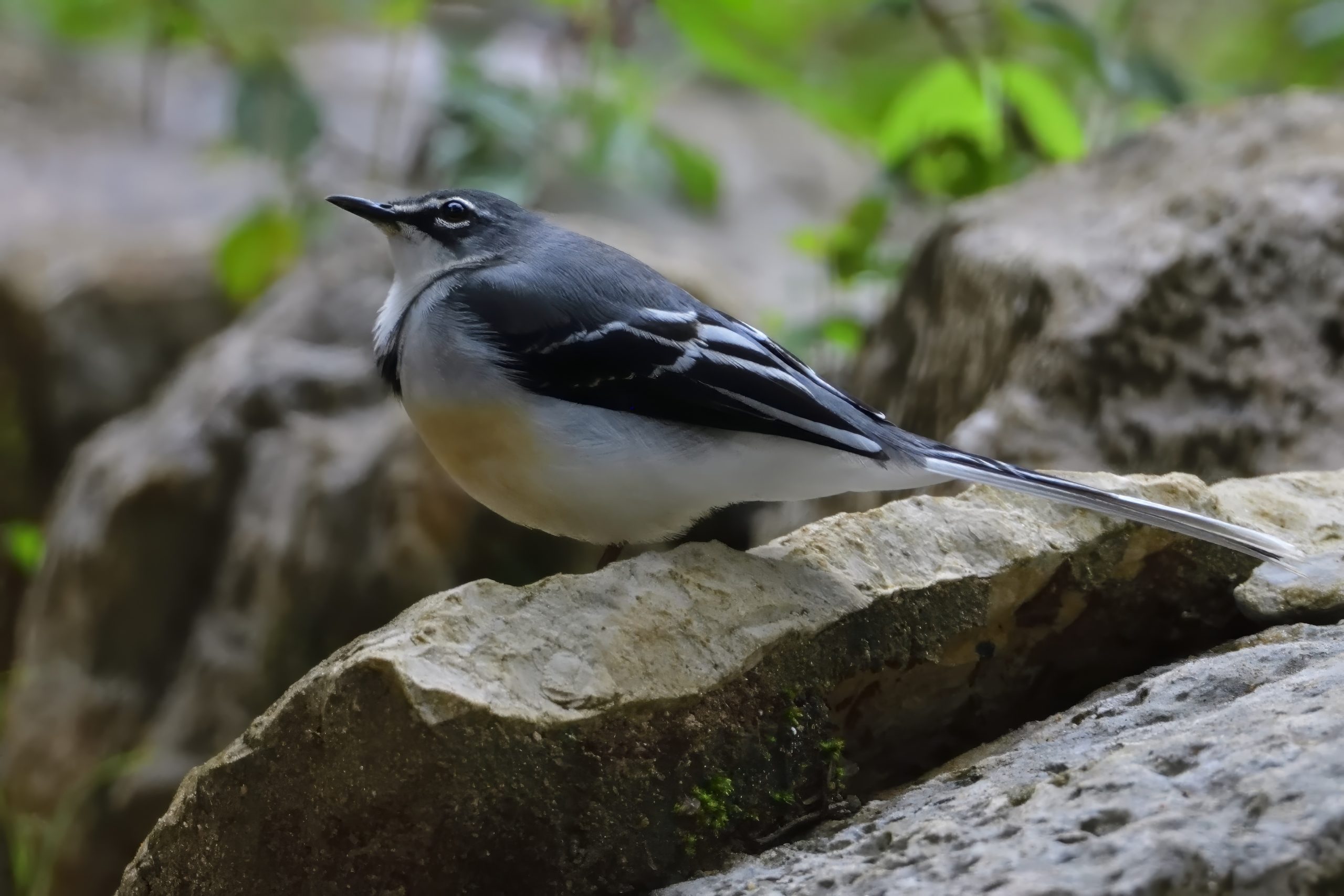
Mountain Wagtail, Motacilla clara
Day 11, Thursday March 20: Amani Forest.
We had coffee at Normal time 06:45, brought with us packed breakfast and started going uphill in my Land Rover. Our first stop was at our normal stop for Long-billed Forest Warbler and Kretchmer´s Longbill. We had picked up Common Waxbill on the way up. The weather was very bad with rain. We walked our normal path and it were very quiet. We returned to the car, ate breakfast and then went for a walk again. It started to live up a little, we got Shelley´s Greenbull, Yellow-streaked Greenbull and African Green Pigeon. We saw glimpses of the Long-billed Forest Warbler and finally one came out and were sitting in the open for a long time. We walked in search of the Cabanis´s Bunting, but did not find it. We did register Fischer´s Turaco and White-eared Barbet though. We retuned to the car and Martin and Silas went in search for the bunting while I went looking for the Longbill. They returned with success. I had just heard a Longbill calling and Silas joined me. We had a fantastic performance of a juvenile and an adult Kretchmer´s Longbill. I have been to this spot many many times and have never seen the bird act like this. I got the best picture ever of this species. Our next stop were the spot for Sharpe´s Akalat. We were again hindered on our approach by a fallen tree. I used my Engineering skills and with a tow rope managed to move the tree enough for us to drive true. The forest were very quiet and no sign of the Akalat. We did pick up a Green Twinspot. Since Silas really wanted the Akalat and he had a few days extra and Nath had gone home, we decided to stay an extra night in Amani. On our way down for lunch, we looked and looked for the Half-collared Kingfisher, no luck. We returned for lunch and did the Botanical garden again in the afternoon. Here are some of the birds we registered: Purple-banded Sunbird, Pale Batis, Eurasian Golden Oriole, Trumpeter Hornbill, Black-bellied Starling and finally Banded Green Sunbird. We retuned to camp freshened up and had dinner.
Some pictures from Day 11:

Long-billed Forest Warbler, Artisornis moreaui, Endemic to East Usambara, TZ and Serra Jeci, N Mozambique

Shelley´s Greenbul, Arizelocichla masukuensis, Endemic to Eastern Arc Mountains of TZ and N Malawi

Kretchmer´s Longbill, Macrosphenus kreschmeri, Endemic to Coastal SE Africa
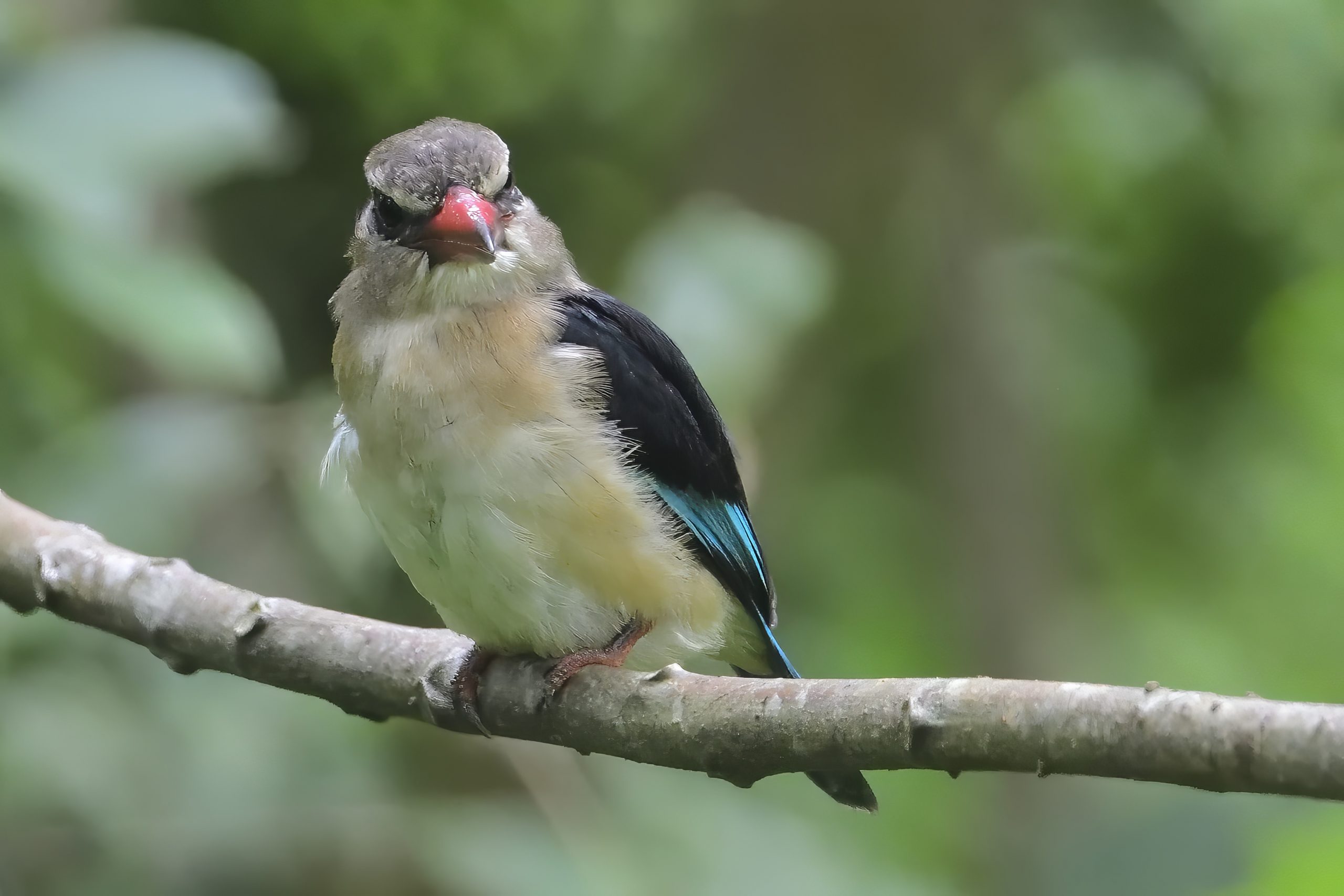
Brown-hooded Kingfisher, Halcyon albiventris

With a tow rope, we managed to move the tree enough to get through on the right hand side.

Usambara Two-horned Chameleon, Kinyongia vosseleri, Endemic to East Usambara, Tanzania
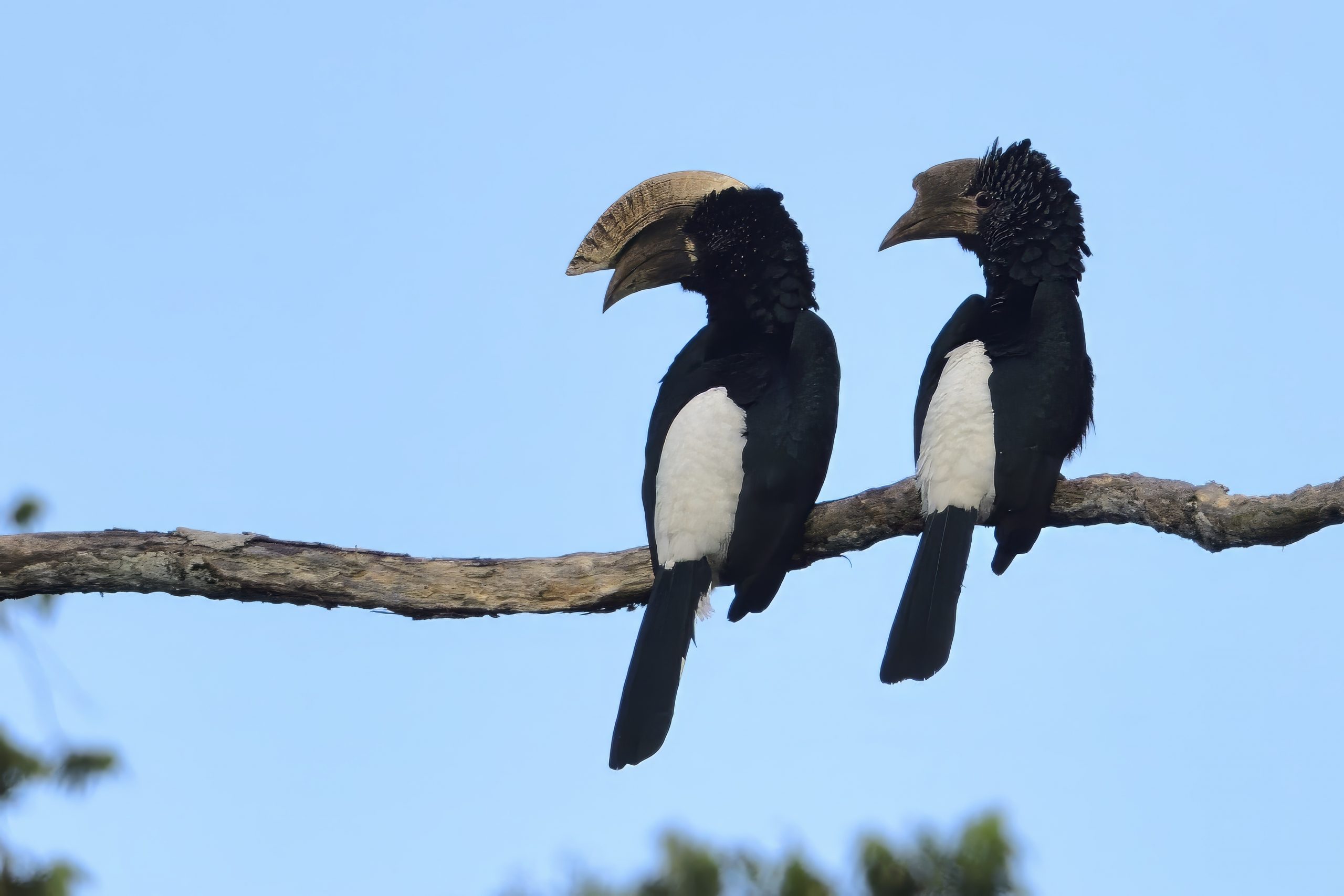
Silvery-cheeked Hornbill, Bycanistis brevis
Day 12, Friday, March 21: Amani Forest
Silas had decided that we should go up and look again for the Sharpe´s Akalat. Still no luck. However, we managed to find the Half-collared Kingfisher for him. Other birds added before lunch included: Little Greenbul, Uluguru Violet-backed Sunbird and Blue-spotted Wood Dove. We came back to camp a little before lunch and Silas needed Little Rush Warbler. We did not find it, but he were rewarded with a Red-tailed Ant Thrush instead. We had lunch, packed and drove down to the new guest house at the Zigi Gate. In the afternoon, we drove down to Zigi Forest and added: Retz´s and Chestnut-fronted Helmetshrikes, Usambara Hyliota, Dark-backed Weaver and Mombasa Woodpecker to our Amani list. We returned to camp, freshened up and had dinner.
One Picture from Day 12:

Cabanis´s Bunting, Emberiza cabanisi
Day 13, Saturday, March 22: Zigi Forest Amani.
We met for coffee at normal time 06:45. We started birding around 7:30 and the forest were very much alive. Our first bird were a Eastern Nicator (TZ Photo Lifer for me). Then we called out a Tanzanian Illadopsis. It were calling back for a long time, but we only managed to get glimpses of it despite it were singing only a few metres from us. We also tried again and again for Green Tinkerbirds, but even though they called back, they did not act in a normal way. We walked down the road and added the following birds: Little Yellow Flycatcher, Grey Tit-Flycatcher, Fischer´s Greenbul, Lowland Tiny Greenbul, Forest Batis, Ashy Flycatcher and Common Square-tailed Drongo. We had breakfast in the forest, but it had gone completely quiet. After breakfast we returned to camp and relaxed until lunch and a few more hours until it started to cool down a little. We returned down to Zigi Forest, walked up the trail and finally got a cooperating Green Tinkerbird. Nothing else were added that afternoon. We returned to camp, freshened up and had dinner.
Some pictures from Day 13:

Eastern Nicator, Nicator gularis

Ashy Flycatcher, Muscicapa caerulescens

Green Tinkerbird, Pogoniulus simplex, Endemic to Coastal SE Africa
Day 14, Sunday March 23: Amani Forest, East Usambara – Kiligolf, Usa River.
We decided to have an early start this day since the forest were so lively when we arrived the day before. That day, it were rather quiet and we did not add any birds on the forest walk. We walked all the way down to the end of the forest and added only the following species: African Goshawk, Little Spotted Woodpecker and Boehm´s Spinetail. We drove down and looked again for Kurrichane Thrush and Spotted Palm Thrush. We only found the first one. We said our goodbyes to Martin in Muheza. Silas and I had a quick stop to fill up Diesel and buy some Samosas and drinks in Segera and then we drove straight home where we arrived earlier than expected. Silas even took a walk on Kiligolf while I just relaxed after the long drive. Later, we freshened up, had dinner and retired early to bed.
Some pictures from Day 14:

Little Yellow Flycatcher, Erythrocercus holochlorus, Endemic to Coastal E Africa

Bronze Mannikin (Juvenile), Lonchura cucullata
Day 15, Monday, March 24: Meru Forest, Ngarasero Lodge and Kalinga Forest
Silas and I had a late morning with breakfast at around 08:30. We met up with Dilenga and headed for Meru Forest. We picked up Speke´s Weavers on the way as normal. The road up were terrible, but at the first stop we got a few birds including Silas targets: Hunter´s Cisticola, Broad-ringed White-eye and Tacazze Sunbird. The road further up were not drivable, so I let Silas and Dilenga walk ahead and I found a way around. When I met up with them, they had connected with young and adults Green-backed Honeybirds. We walked together up to the gate. I have been stopped by a ranger there before, so stopped a little inside the gate where I know it is a very productive spot. Silas and Dilenga went a little further up. I photographed Abbott´s Starling, Yellow-crowned Canaries and a very nice perching Striped-faced Greenbul before I realized, I did not have any memory card in my camera :-). I also registered Yellow-bellied Waxbill, Black Saw-wing and Crowned Eagle. I walked down to the car and soon Silas and Dilenga joined me. We went straight to Usa River where my Boda Boda driver Motor Cycle taxi) were waiting for us with my memory card. We had lunch and drove up to Ngarasero Lodge. It were very quiet, but we got pictures of an African Fish Eagle and we finally found the resident pair of African Black Duck + Rüppel´s Robin-Chat. We left Ngarasero and drove for Kalinga Forest. We made a quick stop at a Village Weaver nesting colony. Then we continued to the Forest. As soon as we entered the forest, we heard a Green Malkoha calling. We had fleeting views of it before we gave up. The forest were quiet, but we managed to connect with another Green Malkoha and several Narina Trogons. The last bird in the forest were a pair of Crowned Hornbills. We returned home and Silas again took a walk on Kiligolf. We freshened up and had dinner. As before we retired early to bed.
Some pictures from day 15:

African Fish Eagle, Haliaeetus vocifer
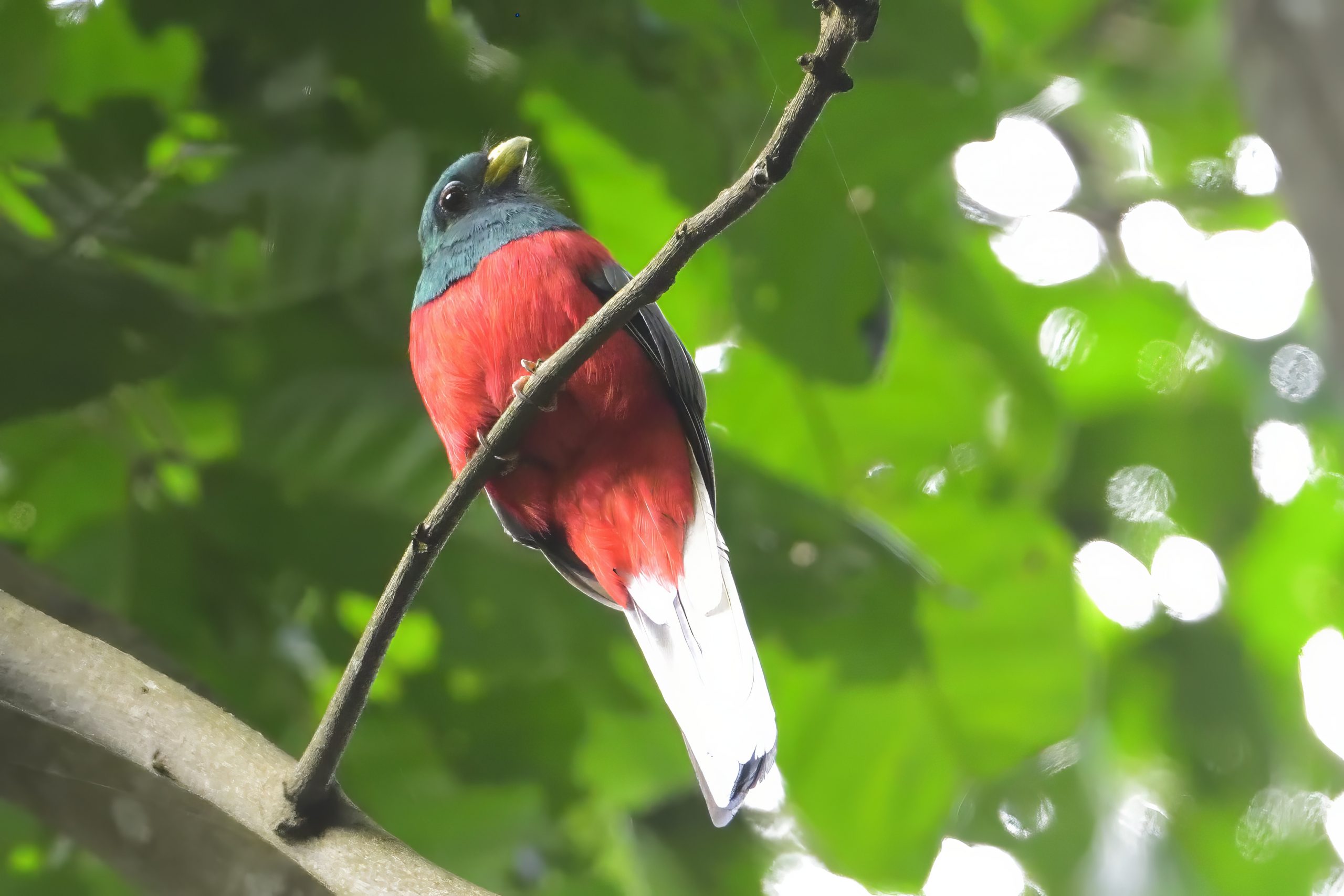
Narina Trogon, Apaloderma narina
Day 16, Tuesday March 25: Arusha National Park
We did not stress that morning either since the park is incredible slow to open. It is supposed to open at 06:30 and when we arrived at 07:40, they just opened. I did my normal loop, but the park were quiet. On the way to the museum, we managed to add the following species: Moustached Grass Warbler, Bronzy Sunbird, Singing Cisticola and White-browed Coucal. Not much going on on the left fork off the road on the Ngurduto Crater, but we added Tambourine Dove, Brown Woodland Warbler, Evergreen Forest Warbler, White-starred Robin and African Olive Pigeon. On the right fork of the Crater it were very quiet. We had breakfast and drove down to the museum again. We stopped and listened , but nothing new. We drove on towards the lake and stopped at a couple of wetlands and only added Spot-flanked Barbet to our list. Once we came out into the open area before the lakes, we stopped by a wetland and found a new trip bird for me: Black-crowned Tchagra. On the way down to the lakes, we added Whinchat, Rufous-naped Lark, Trilling and Short-winged Cisticola and a Garden Warbler. No sign of any Southern Pochards again, but added a surprise Ashy Cisticola, before we crossed to the new pavillion where we got Winding Cisticola and a couple of Vaders including Little Stint, Three-banded Plover and Wood Sandpiper. We drove on around the lakes and found Reed and White-breasted Cormorants, Lesser and Greater Flamingo, Pied Avocet, Ruff, Cape Teal, Sand Martin, Long-billed Pipit and Pangani Longclaw. The road up to the Waterfalls of Mt. Meru were in a terrible condition, but we managed to get up just as it started to drizzle a little bit. We had overflying Red-fronted Parrots at our lunch site. On the way down, we found both Sharpe´s and Abbott´s Starling, Broad-ringed White-eye and Scaly Spurfowl. We stopped at the Fig tree, but nothing moving so we continued down the mountain and out towards the gate. On the Little Serengeti we finally found our first Long-crested Eagle of the trip. On the last stretch, we had a female African Stonechat displaying nicely for us. We clocked out around 18:00, stopped for some shopping and drove home. The trip were now officially over. Silas were not leaving before March 28th though.
Here are some pictures from the last day:

Black-crowned Tchagra, Tchagra senegalus

Whinchat, Saxicola rubetra

Ashy Cisticola, Cisticola, Cisticola cinereolus, Endemic to NE Africa

Scaly Spurfowl, Pternistis squamatus

Sharpe´s Starling, Poeoptera sharpii, Endemic to NE Africa

African Stonechat (female), Saxicola torquatus

Silas and me by the Fig Tree in Arusha NP.
Unfortunately Nath had to leave us so Silas and I continued the trip. We reached a new record for my Usambara trip with a staggering 475 species of birds recorded. I managed to get a couple of lifers and a few TZ Photo lifers and a few new trip birds, so all in all a good trip. Silas stayed on for a few days and did some more bordong on Kiligolf. April will be a quiet month for me. I have had a couple of birders visiting and are tidying up some logistics for my next 3 week trip starting on May 2nd, where I will do Coastal TZ and Kenya with a visit to Taita Hills on the way back. Stay tuned. I have now seen 891 species in Tanzania and Photographed 845. For East Africa, the numbers are 1133 Seen and 1086 Photographed.